Netgear orporated WG311TV3 108 Mbps Wireless PCI Adapter User Manual WG311T
Netgear Incorporated 108 Mbps Wireless PCI Adapter WG311T
users manual
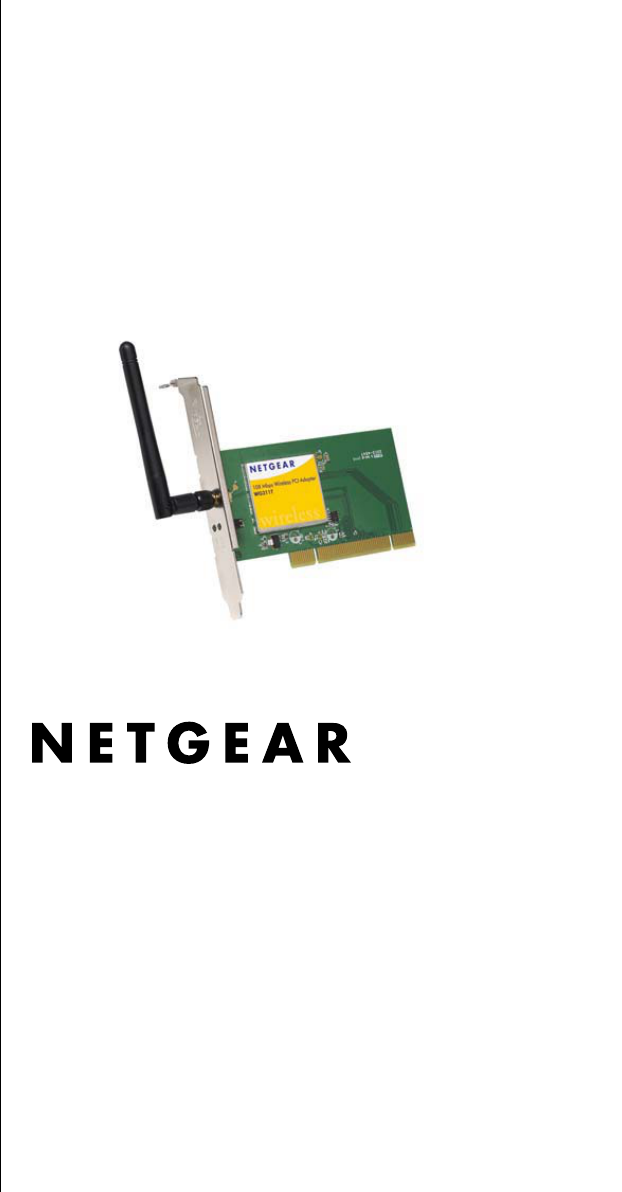
202-10070-01
Version v3.0
December 2004
NETGEAR, Inc.
4500 Great America Parkway
Santa Clara, CA 95054 USA
Installation Guide for the
NETGEAR 108 Mbps
Wireless PCI Adapter
WG311T

ii
Technical Support
Please refer to the support information card that shipped with your product. By registering your
product at www.netgear.com/register, we can provide you with faster expert technical support and
timely notices of product and software upgrades.
NETGEAR, INC. Support Information
Phone: 1-888-NETGEAR, for US & Canada only. For other countries, see your Support
information card.
E-mail: support@netgear.com
Web site: www.netgear.com
Statement of Conditions
In the interest of improving internal design, operational function, and/or reliability, NETGEAR reserves the right to
make changes to the products described in this document without notice.
NETGEAR does not assume any liability that may occur due to the use or application of the product(s) or circuit
layout(s) described herein.
©2004 NETGEAR, Inc. NETGEAR, the NETGEAR logo, The Gear Guy and Everybody's Connecting are
trademarks or registered trademarks of NETGEAR, Inc. in the United States and/or other countries.
Microsoft and Windows are registered trademarks of Microsoft Corporation in the United States and/or
other countries. Other brand and product names are trademarks or registered trademarks of their respective
holders. Information is subject to change without notice. All rights reserved.
December 2004
Certificate of the Manufacturer/Importer
It is hereby certified that the Model WG311T Wireless PCI Adapter has been suppressed in accordance with the
conditions set out in the BMPT- AmtsblVfg 243/1991 and Vfg 46/1992. The operation of some equipment (for example,
test transmitters) in accordance with the regulations may, however, be subject to certain restrictions. Please refer to the

iii
notes in the operating instructions.
Federal Office for Telecommunications Approvals has been notified of the placing of this equipment on the market and
has been granted the right to test the series for compliance with the regulations.
FCC Information to User
This product does not contain any user serviceable components and is to be used with approved antennas
only. Any product changes or modifications will invalidate all applicable regulatory certifications and
approvals
FCC Guidelines for Human Exposure
In order to comply with RF exposure limits established in the ANSI C95.1 standards, the user is advised to maintain a
distance of at least 1 inch (2.5 cm) from the antenna of this device while it is in use.
FCC Electronic Emission Notices
This device complies with part 15 of the FCC Rules.
Operation is subject to the following two conditions:
1. This device may not cause harmful interference
2. This device must accept any interference received, including interference that may cause undesired operation.
FCC Radio Frequency Interference Statement
This equipment has been tested and found to comply with the limits for a class B digital device, pursuant to Part 15 of
the FCC Rules. These limits are designed to provide reasonable protection against harmful interference when the
equipment is operated in a commercial environment. This equipment generates, uses and can radiate radio frequency
energy and, if not installed and used in accordance with the instructions, may cause harmful interference to radio
communications.
Operation of this equipment in a residential area may cause harmful interference, in which case the user will be required
to correct the interference at his own expense.
NETGEAR 108 Mbps Wireless PCI Adapter WG311T
FOR HOME OR OFFICE USE
Tested to Comply
with FCC Standards
FCC ID: PY3WG311TV3

iv
If this equipment does cause harmful interference to radio or television reception, which can be determined by turning
the equipment off and on, the user is encouraged to try to correct the interference by one or more of the following
measures:
• Reorient or relocate the receiving antenna
• Increase the separation between the equipment and receiver
• Connect the equipment into an outlet on a circuit different from that to which the receiver is connected
• Consult the dealer or an experienced radio/TV technician for help
Export Restrictions
This product or software contains encryption code which may not be exported or transferred from the US or
Canada without an approved US Department of Commerce export license.
Canadian Department of Communications Radio Interference
Regulations
This digital apparatus (Model WG311T Wireless PCI Adapter) does not exceed the Class B limits for radio-noise
emissions from digital apparatus as set out in the Radio Interference Regulations of the Canadian Department of
Communications.
Canada ID: 4054A-WG311TV3
Contents v
Contents
Chapter 1
Introduction
About the NETGEAR 108 Mbps Wireless PCI Adapter WG311T ...................................1-1
Key Features and Related NETGEAR Products ............................................................1-1
What’s in the Box? ..........................................................................................................1-2
A Road Map for ‘How to Get There From Here’ .............................................................1-3
Chapter 2
Basic Setup
What You Will Need Before You Begin ...........................................................................2-1
Verify System Requirements ....................................................................................2-1
Observe Location and Range Guidelines ................................................................2-2
Two Basic Operating Modes ...........................................................................................2-2
WG311T Default Wireless Configuration Settings ..........................................................2-3
Basic Installation Instructions .........................................................................................2-4
For Windows XP Users Installing a WG311T ...........................................................2-4
For Windows 2000 & 98SE/Me Users Installing a WG311T .....................................2-8
WG311T Wireless Connection Indicators .....................................................................2-12
Interpreting System Tray Icon Colors .....................................................................2-12
Basic Troubleshooting Tips ...........................................................................................2-13
About Page ...................................................................................................................2-14
Chapter 3
Configuration
Understanding the Configuration Options ......................................................................3-1
Using Configuration Profiles ...........................................................................................3-1
Networks Page ...............................................................................................................3-2
Connecting to an Access Point in Infrastructure Mode ...................................................3-3
How to Configure an Infrastructure Mode Profile .....................................................3-3
Connecting to Another PC in Ad-Hoc Mode ...................................................................3-5
How to Configure an Ad-Hoc Mode Profile ..............................................................3-5
Enabling Wireless Security Features ..............................................................................3-8
Identifying the Wireless Security Settings ................................................................3-9
vi Contents
How to Configure WEP Encryption Security ..........................................................3-10
How to Configure WPA-PSK Encryption Security .................................................. 3-11
Statistics Page ..............................................................................................................3-12
Advanced Settings Page ..............................................................................................3-13
Chapter 4
Troubleshooting
Frequently Asked Questions ..........................................................................................4-1
General Questions ...................................................................................................4-1
Why do I see no more than 54 Mbps on the Configuration Utility status line? ..4-1
The WG311T Smart Configuration Utility keeps asking me to save my settings 4-1
Ad Hoc mode is not working correctly ...............................................................4-2
How to know if the WG311T card has received a valid IP address from the Wireless
Router/AP ..........................................................................................................4-2
How to use XP’s own Wireless configuration utility that comes with Windows XP 4-2
How to remove the WG311T utility and software ...............................................4-2
I cannot connect to the AP that I want from the Networks browser list .............4-3
The WG311T is not getting an IP address .........................................................4-3
Wi-Fi Protected Access (WPA) Questions ...............................................................4-3
Why is my WG311T not connecting to my WPA router? ....................................4-3
Why is the icon in the System Tray flashing Green to Red alternately? ............4-3
How do I know that my WG311T WPA is working? ...........................................4-4
Why is the WAN port not working after configuring WPA? ................................4-4
Appendix A
Technical Specifications
Appendix B
Wireless Networking Basics
Wireless Networking Overview ...................................................................................... B-1
Infrastructure Mode ................................................................................................. B-1
Ad-Hoc Mode (Peer-to-Peer Workgroup) ................................................................ B-2
Network Name: Extended Service Set Identification (ESSID) ................................ B-2
Authentication and WEP ................................................................................................ B-2
802.11 Authentication .............................................................................................. B-3
Open System Authentication ................................................................................... B-3
Shared Key Authentication ...................................................................................... B-4
Overview of WEP Parameters ................................................................................ B-5
Key Size .................................................................................................................. B-6
Contents vii
WEP Configuration Options .................................................................................... B-6
Wireless Channels ......................................................................................................... B-7
WPA Wireless Security .................................................................................................. B-8
How Does WPA Compare to WEP? ........................................................................ B-9
How Does WPA Compare to IEEE 802.11i? ........................................................ B-10
What are the Key Features of WPA Security? ...................................................... B-10
WPA Authentication: Enterprise-level User
Authentication via 802.1x/EAP and RADIUS .................................................. B-12
WPA Data Encryption Key Management ........................................................ B-14
Is WPA Perfect? .................................................................................................... B-16
Product Support for WPA ...................................................................................... B-16
Supporting a Mixture of WPA and WEP Wireless Clients is Discouraged ...... B-16
Changes to Wireless Access Points ............................................................... B-17
Changes to Wireless Network Adapters ......................................................... B-17
Changes to Wireless Client Programs ............................................................ B-18
Appendix C
Preparing Your PCs for Network Access
Preparing Your Computers for TCP/IP Networking ....................................................... C-1
Configuring Windows 98SE and Me for TCP/IP Networking ......................................... C-1
Install or Verify Windows Networking Components ................................................. C-1
Enabling DHCP to Automatically Configure TCP/IP Settings in Windows 98SE and Me
C-3
Selecting the Internet Access Method ..................................................................... C-5
Verifying TCP/IP Properties .................................................................................... C-5
Configuring Windows 2000 or XP for TCP/IP Networking ............................................. C-6
Install or Verify Windows Networking Components ................................................. C-6
DHCP Configuration of TCP/IP in Windows XP or 2000 ......................................... C-7
DHCP Configuration of TCP/IP in Windows XP ..................................................... C-7
DHCP Configuration of TCP/IP in Windows 2000 .................................................. C-9
Verifying TCP/IP Properties for Windows XP or 2000 ........................................... C-11
Glossary
List of Glossary Terms ................................................................................................... D-1
Index
viii Contents

Installation Guide for the NETGEAR 108 Mbps Wireless PCI Adapter WG311T
Introduction 1-1
Chapter 1
Introduction
This chapter introduces the features, package contents, and appearance of the NETGEAR 108
Mbps Wireless PCI Adapter WG311T.
About the NETGEAR 108 Mbps Wireless PCI Adapter
WG311T
The NETGEAR 108 Mbps Wireless PCI Adapter WG311T gives you flexibility to install the PC in
the most convenient location available. The WG311T frees you from traditional Ethernet wiring
that is limited by cabling requirements.
Its auto-sensing capability allows high packet transfer up to 108 Mbps for maximum throughput or
dynamic range shifting to lower speeds due to distance or operating limitations in an environment
with a lot of electromagnetic interference.
The WG311T Wireless PCI Adapter provides reliable, standards-based 802.11b 11 Mbps Wireless
Local Area Network (WLAN) connectivity that is protected with industry-standard security. In
addition, it offers the faster speeds of the 802.11g standard. The WG311T works with Windows
98SE, Me, 2000, and XP operating systems.
Key Features and Related NETGEAR Products
The WG311T Wireless PCI Adapter provides the following features:
• Reliable IEEE 802.11b/g standards-based wireless technology.
• Supports roaming between access points when configured in Infrastructure mode.
• 108 Mbps high speed data transfer. Wireless nodes negotiate to operate in the optimal data
transfer rate. In a noisy environment or when the distance between the wireless nodes is far,
the wireless nodes automatically fall back to operate at lower transfer rates.

Installation Guide for the NETGEAR 108 Mbps Wireless PCI Adapter WG311T
1-2 Introduction
• High level of data encryption using128-bit Shared Key WEP data encryption method. Lower
level of data encryption or no data encryption is available to simplify your network setup or to
improve the data transfer rate.
The following NETGEAR products can be configured to communicate with the WG311T Wireless
PCI Adapter:
• WGT634U 108 Mbps Wireless Media Router
• WGT624 108 Mbps Wireless Firewall Router
• WG602 54 Mbps Wireless Access Point
• WGR614 54 Mbps Cable/DSL Wireless Router
• WGR511 54 Mbps Wireless PC Card
• MA111 802.11b Wireless USB Adapter
• ME103 802.11b ProSafe Wireless Access Point
• MA311 802.11b Wireless PCI Adapter
• MR814 802.11b Wireless Cable/DSL Routers
• MA521 802.11b Wireless Compact Flash Card
What’s in the Box?
The product package should contain the following items:
• NETGEAR 108 Mbps Wireless PCI Adapter WG311T
• Installation Guide for the NETGEAR 108 Mbps Wireless PCI Adapter WG311T
•NETGEAR 108 Mbps Wireless PCI Adapter WG311T Resource CD, including:
— Driver Software
— Wireless Assistant
— Installation Guide
• Warranty card
• Support information card
If any of the parts are incorrect, missing, or damaged, contact your NETGEAR dealer. Keep the
carton, including the original packing materials, in case you need to return the product for repair.

Installation Guide for the NETGEAR 108 Mbps Wireless PCI Adapter WG311T
Introduction 1-3
A Road Map for ‘How to Get There From Here’
The introduction and adoption of any new technology can be a difficult process. Wireless
technology has removed one of the barriers to networking—running wires. It allows more people
to try networking, while at the same time exposes them to the inherent complexity of networking.
General networking concepts, set up, and maintenance can be difficult to understand. In addition,
wireless technology adds issues such as range, interference, signal quality, and security to the
picture.
To help overcome potential barriers to successfully using wireless networks, the table below
identifies how to accomplish such things as connecting to a wireless network, assuring appropriate
security measures are taken, browsing the Internet through your wireless connection, exchanging
files with other computers and using printers in the combined wireless and wired network.
Table 1-1. A Road Map for How to Get There From Here
If I Want To ... ? What Do I Do? What’s Needed? How Do I?
Connect to a
wireless
network
1. Identify the
wireless
network name
(SSID) and, if
used, the
wireless
security
settings.
2. Set up the
NETGEAR
108 Mbps
Wireless PCI
Adapter
WG311T with
the settings
from step 1.
1. A wireless network
2. A desktop PC within the
operating range of the wireless
network. For guidelines about
the range of 802.11b/g
wireless networks, please see
“Observe Location and Range
Guidelines” on page 2-2.
To set up the WG311T, see
Chapter 2, “Basic Setup” and
follow the instructions provided.
To learn about wireless
networking technology, see
Appendix B, “Wireless
Networking Basics” for a general
introduction.

Installation Guide for the NETGEAR 108 Mbps Wireless PCI Adapter WG311T
1-4 Introduction
Protect my
wireless
connection from
snooping,
hacking, or
information
theft.
1. Assure that the
wireless
network has
security
features
enabled.
2. Configure my
WG311T with
the security
settings of the
wireless
network.
3. Use Windows
security
features.
1. A wireless network with
authentication and WEP
encryption enabled.
2. Wireless networking
equipment that supports WEP
encryption, such as the
WG311T and all NETGEAR
wireless networking products.
To learn about wireless
networking security, see
“Authentication and WEP” on
page B-2.
To use wireless security
features, please see “Enabling
Wireless Security Features” on
page 3-8 and configure your
WG311T accordingly.
Note: Secure Internet sites such as banks and online merchants use encryption security built into browsers
like Internet Explorer and Netscape. Any wireless networking security features you might implement are in
addition to those already in place on secure Internet sites.
Connect to the
Internet over my
wireless
network.
1. Activate my
wireless link
and verify my
network
connection.
2. Open an
Internet
browser such
as Internet
Explorer or
Netscape
Navigator.
1. An active Internet connection
like those from cable or DSL
service providers.
2. A wireless network connected
to the cable or DSL Internet
service through a cable/DSL
router as illustrated in
“Connecting to an Access
Point in Infrastructure Mode”
on page 3-3.
3. TCP/IP Internet networking
software installed and
configured on my PC
according to the requirements
of the Internet service provider
4. A browser like Internet
Explorer or Netscape
Navigator.
To configure your WG311T in
Infrastructure Mode, see “Basic
Installation Instructions” on
page 2-4, and locate the section
for your version of Windows.
For assistance with configuring
the TCP/IP Internet software on
a PC, see “Preparing Your
Computers for TCP/IP
Networking” on page C-1 or refer
to the PC Networking Tutorial on
the NETGEAR 108 Mbps
Wireless PCI Adapter WG311T
Resource CD and the Help
information provided in the
Windows system you are using.
.
Table 1-1. A Road Map for How to Get There From Here
If I Want To ... ? What Do I Do? What’s Needed? How Do I?

Installation Guide for the NETGEAR 108 Mbps Wireless PCI Adapter WG311T
Introduction 1-5
Exchange files
between a
wirelessly
connected
notebook
computer and
other
computers in a
my combined
wireless and
wired
network.
1. Use the
Windows
Network
Neighborhood
feature to
browse for
computers in
the combined
wireless and
wired network.
2. Browse the
hard drive of
the target
computer in
the network in
order to locate
the directory or
files you want
to work with.
3. Use the
Windows
Explorer copy
and paste
functions to
exchange files
between the
computers.
1. The desktop computer I am
using to connect to the
wireless network needs to be
configured with the Windows
Client and File and Print
Sharing.
2. The desktop computer I am
using to connect to the
wireless network needs to be
configured with the same
Windows Workgroup or
Domain settings as the other
Windows computers in the
combined wireless and wired
network.
3. Any Windows networking
security access rights such as
login user name/ password
that have been assigned in the
Windows network or for
sharing particular files must be
provided when Windows
prompts for such information.
4. If so-called Windows ‘peer’
Workgroup networking is being
used, the drive, file system
directory, or file need to be
enabled for sharing.
For assistance with Windows
networking software, see
Appendix C, “Preparing Your
PCs for Network Access” for
configuration scenarios or refer
to the Help system included with
your version of Windows.
Windows Domain settings are
usually managed by corporate
computer support groups.
Windows Workgroup settings
are commonly managed by
individuals who want to set up
small networks in their homes, or
small offices.
For assistance with setting up
Windows networking, refer to the
PC Networking Tutorial on the
NETGEAR 108 Mbps Wireless
PCI Adapter WG311T Resource
CD and the Help information
provided in the Windows system
you are using.
Table 1-1. A Road Map for How to Get There From Here
If I Want To ... ? What Do I Do? What’s Needed? How Do I?

Installation Guide for the NETGEAR 108 Mbps Wireless PCI Adapter WG311T
1-6 Introduction
Use printers in
a combined
wireless and
wired
network.
1. Use the
Windows
Printers and
Fax features to
locate
available
printers in the
combined
wireless and
wired network.
2. Use the
Windows Add
a Printer
wizard to add
access to a
network printer
from the PC
you are using
to wirelessly
connect to the
network.
3. From the File
menu of an
application
such as
Microsoft
Word, use the
Print Setup
feature to
direct your
print output to
the printer in
the network.
1. The desktop computer I am
using to connect to the
wireless network needs to be
configured with the Windows
Client and File and Print
Sharing.
2. The desktop computer I am
using to connect to the
wireless network needs to be
configured with the same
Windows Workgroup or
Domain settings as the other
Windows computers in the
combined wireless and wired
network.
3. Any Windows networking
security access rights such as
login user name/ password
that have been assigned in the
Windows network must be
provided when Windows
prompts for such information.
4. If so-called Windows ‘peer’
networking is being used, the
printer needs to be enabled for
sharing.
Windows Domain settings are
usually managed by corporate
computer support groups.
Windows Workgroup settings
are commonly managed by
individuals who want to set up
small networks in their homes, or
small offices.
For assistance with setting up
Windows networking, refer to the
PC Networking Tutorial on the
NETGEAR 108 Mbps Wireless
PCI Adapter WG311T Resource
CD and the Help information
provided in the Windows system
you are using.
For assistance with setting up
printers in Windows, refer to the
Help and Support information
that comes with the version of
the Windows operating systems
you are using.
Table 1-1. A Road Map for How to Get There From Here
If I Want To ... ? What Do I Do? What’s Needed? How Do I?

Basic Setup 2-1
Chapter 2
Basic Setup
This section describes how to install your NETGEAR 108 Mbps Wireless PCI Adapter WG311T
and set up basic wireless connectivity on your Wireless Local Area Network (WLAN). Advanced
wireless network configuration is covered in Chapter 3, “Configuration” in this manual.
What You Will Need Before You Begin
You need to verify that your computer meets the minimum system requirements and identify the
wireless network configuration settings of the WLAN where you will connect before you can
configure your wireless pc adapter and connect.
Verify System Requirements
Before installing the NETGEAR 108 Mbps Wireless PCI Adapter WG311T, please make sure that
these minimum requirements have been met:
• Pentium® III class computer with an available PCI slot
•CD-ROM drive
• 20 Mbytes of free hard disk space
• Some versions of Windows may ask for the original Windows operating system installation
files to complete the installation of the WG311T driver software
Note: Indoors, computers can easily connect to 802.11 wireless networks at distances of
several hundred feet. Because walls do not always block wireless signals, others from
outside your immediate area could access your network. It is important to take
appropriate steps to secure your network from unauthorized access. The NETGEAR
108 Mbps Wireless PCI Adapter WG311T provides highly effective security features
which are covered in “Enabling Wireless Security Features” on page 3-8. Deploy the
security features appropriate to your needs.

Installation Guide for the NETGEAR 108 Mbps Wireless PCI Adapter WG311T
2-2 Basic Setup
Observe Location and Range Guidelines
Computers can connect over 802.11g wireless networks indoors at a range which varies
significantly based on the physical location of the computer with the NETGEAR 108 Mbps
Wireless PCI Adapter WG311T. For best results, avoid potential sources of interference, such as:
• Large metal surfaces
•Microwaves
• 2.4 GHz Cordless phones
In general, 802.11g wireless devices can communicate through walls. However, if the walls are
constructed with concrete, or have metal, or metal mesh, the 802.11g effective range will decrease
if such materials are between the devices.
Two Basic Operating Modes
The WG311T Wireless PCI Adapter, like all 802.11b/g adapters, can operate in the following two
basic modes:
•Infrastructure Mode:An 802.11 networking framework in which devices and computers
communicate with each other by first going through an access point (AP). For example, this
mode is used when computers in a house connect to an AP that is attached to a router which
lets multiple computers share a single Cable or DSL broadband Internet connection.
•Ad-Hoc Mode: An 802.11 networking framework in which devices or computers
communicate directly with each other, without the use of an access point. For example,
Ad-Hoc Mode is used when two Windows computers are configured with file and print
sharing enabled and you want to exchange files directly between them.
Both of these configuration options are available with the WG311T Wireless PCI Adapter.
Infrastructure configuration procedures for basic network connectivity are covered below.
Advanced infrastructure configuration procedures and ad-hoc configuration are covered in
Chapter 3, “Configuration” of this manual.

Installation Guide for the NETGEAR 108 Mbps Wireless PCI Adapter WG311T
Basic Setup 2-3
WG311T Default Wireless Configuration Settings
If this is a new wireless network installation, use the factory default settings to set up the network
and verify wireless connectivity. If this is an addition to an existing wireless network, you will
need to identify the wireless configuration and security parameters already defined.
Your NETGEAR 108 Mbps Wireless PCI Adapter WG311T factory default basic settings are:
• Network Name Service Set Identification (SSID): ANY — a special name which indicates the
first available network will be used
Note: In order for the WG311T Wireless PCI Adapter to communicate with a wireless access
point or wireless adapter, all devices must be configured with the same wireless network name
(SSID).
• Network Mode (Infrastructure or Ad-Hoc): Infrastructure
• Data security WEP encryption: Disabled
The section below provides instructions for setting up the NETGEAR 108 Mbps Wireless PCI
Adapter WG311T for basic wireless connectivity to an access point. The procedures provide
step-by-step installation instructions for Windows PCs. Use the procedure that corresponds to the
version of Windows you are using.
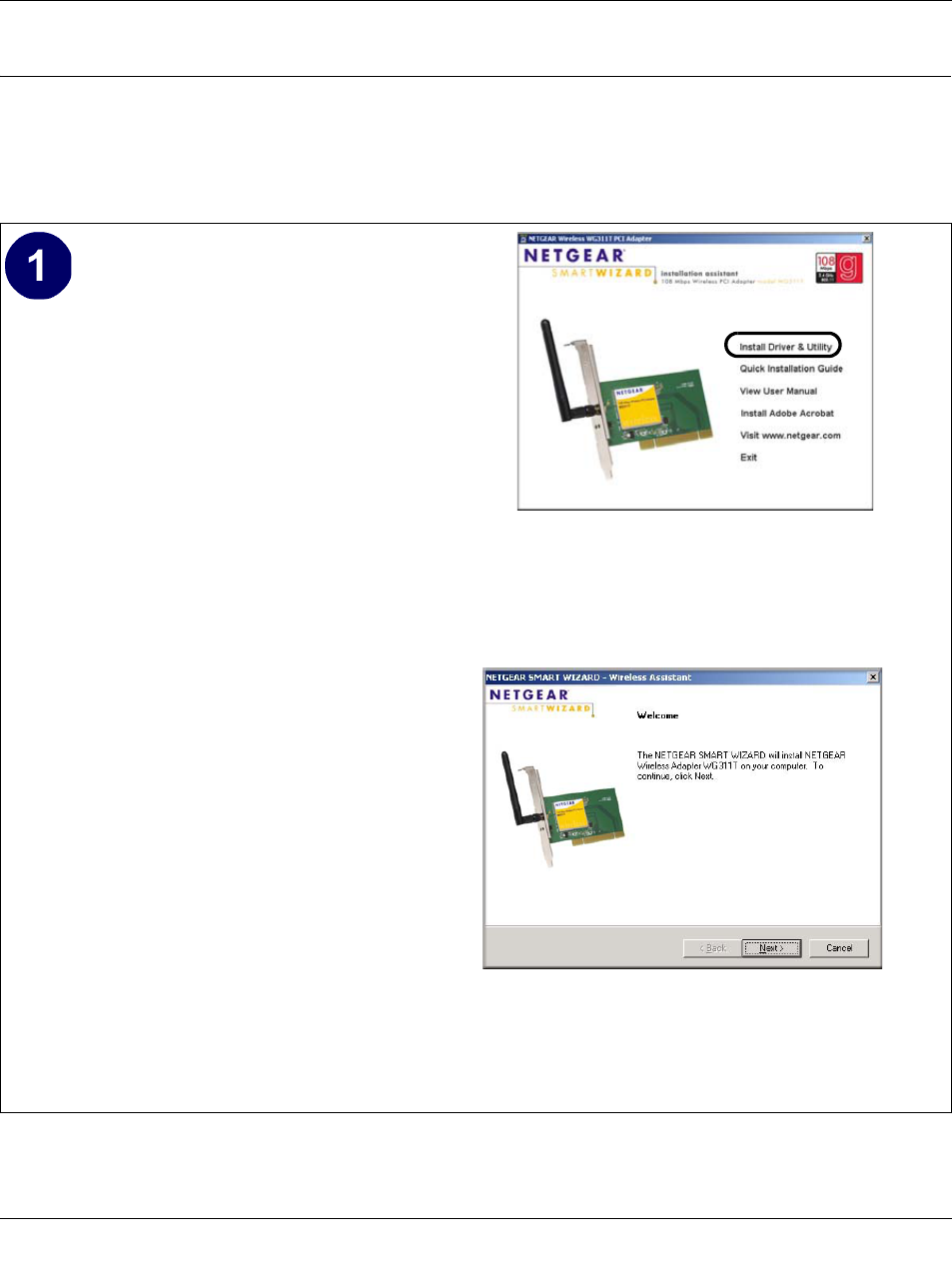
Installation Guide for the NETGEAR 108 Mbps Wireless PCI Adapter WG311T
2-4 Basic Setup
Basic Installation Instructions
Use the procedure below that corresponds to the version of Windows you are using.
For Windows XP Users Installing a WG311T
Install the WG311T software.
a. Power on your computer, let the
operating system boot up completely,
and log in as needed.
b. Insert the NETGEAR 108 Mbps Wireless
PCI Adapter WG311T Resource CD into
your CD-ROM drive. The CD main page
shown at the right will load.
c. Click the “Install Driver & Utility” link.
d. Follow the Smart Wizard - Install
Assistant steps, and click Finish when
done to restart your computer.
WG311T Resource CD
Note: If this page does not automatically appear,
browse the root of the CD and double-click on
autorun.exe to display this page.
Smart Wizard - Install Assistant
Note: If a Windows XP Certification warning appears,
click Continue Anyway to proceed.
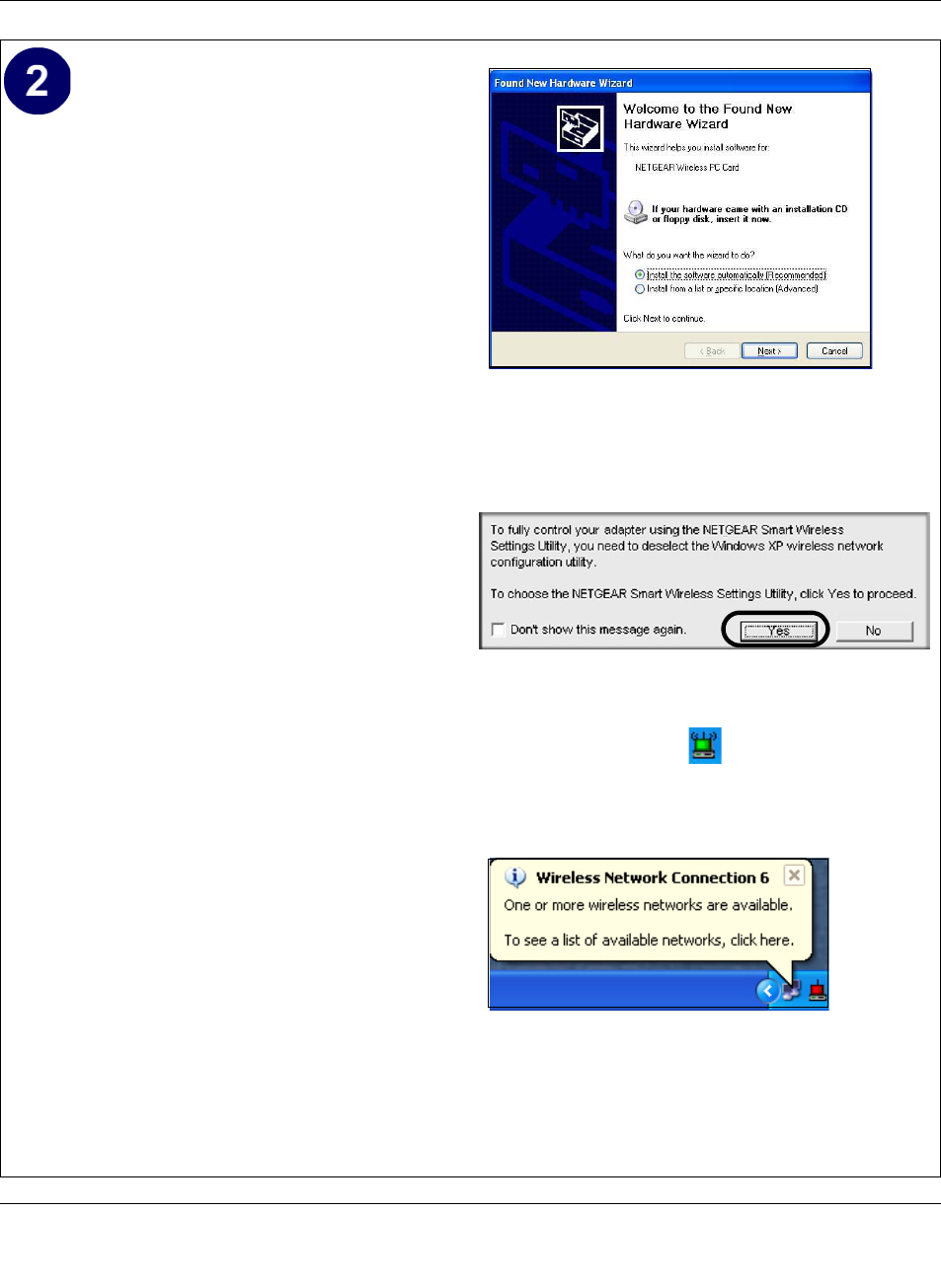
Installation Guide for the NETGEAR 108 Mbps Wireless PCI Adapter WG311T
Basic Setup 2-5
Install the NETGEAR 108 Mbps Wireless
PCI Adapter WG311T.
a. Shut down the PC and remove the power
cord. Insert the WG311T Wireless PCI
Adapter into an available PCI slot.
Connect the antenna to the adapter and
position the antenna to the up position.
Reconnect the power cord and reboot the
computer.
b. The Found New Hardware Wizard
displays. Click Next and follow the
prompts to proceed.
Click Continue Anyway if you are
prompted with a Windows XP Logo
testing message.
c. You will be prompted to choose the country
where you are located. Select your location
from the list.
d. You also will be prompted to enable the
NETGEAR Smart Wireless Settings Utility
configuration utility.
Click Yes to accept this option.
If you choose No, you must read the Win-
dows XP documentation to learn
how to use the Windows XP wireless net-
work configuration utility.
e. After the installation completes, click
Finish to close the wizard.
You should see the WG311T system tray
icon on the lower right portion of the
Windows task bar.
Windows XP will display a Wireless
Network Connection message.
Add New Hardware Wizard
WG311T System Tray Icon
Windows XP Network Connection Alert
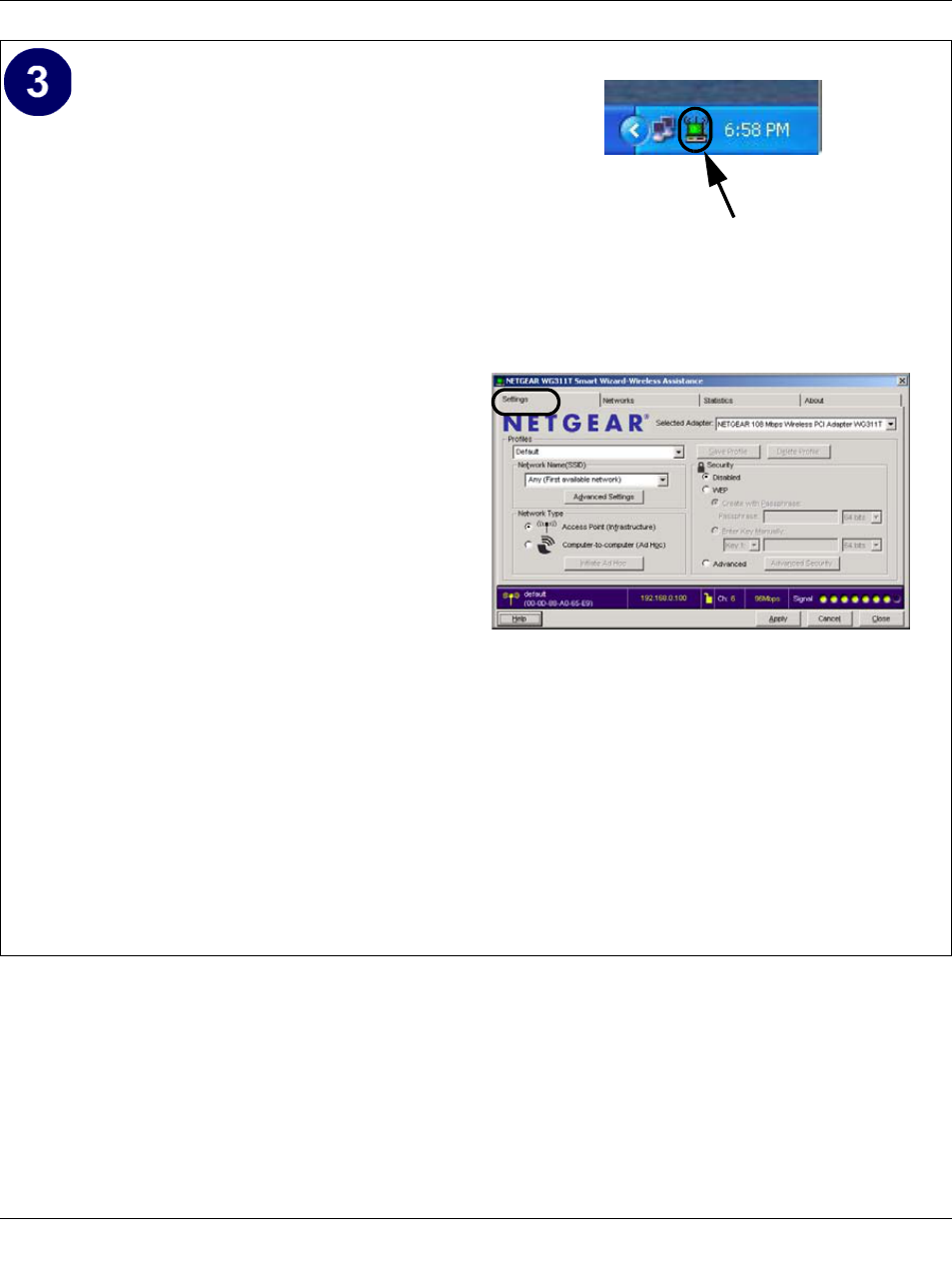
Installation Guide for the NETGEAR 108 Mbps Wireless PCI Adapter WG311T
2-6 Basic Setup
Configure your WG311T and save the
Profile.
a. Open the WG311T Smart Wireless
Configuration Utility by clicking on the
icon in the Windows system tray. The
utility opens to the Settings page.
b. Change the Network Name SSID to
match your network.
Tip: As an alternative to typing in the
SSID, you can use the Network tab to
view the available wireless networks.
Double-click on the desired network.
c. Click Apply to activate the connection.
d. Enter a name for your profile and click
Save Profile to store the current settings.
Tip: If you use your notebook PC to
connect to a wireless network at work
and at home, create profiles called work
and home.
Note: This procedure assumes your wireless
network is not using security. If your wireless
network uses WEP or WPA-PSK, set up your
WG311T accordingly. To view the wireless
security settings help, click the Help button.
Click the system tray icon to open the Smart Wireless
Configuration utility.
WG311T Configuration Utility
Note: The NETGEAR default settings are
Infrastructure mode, with ANY for the wireless
network name SSID, and WEP disabled.
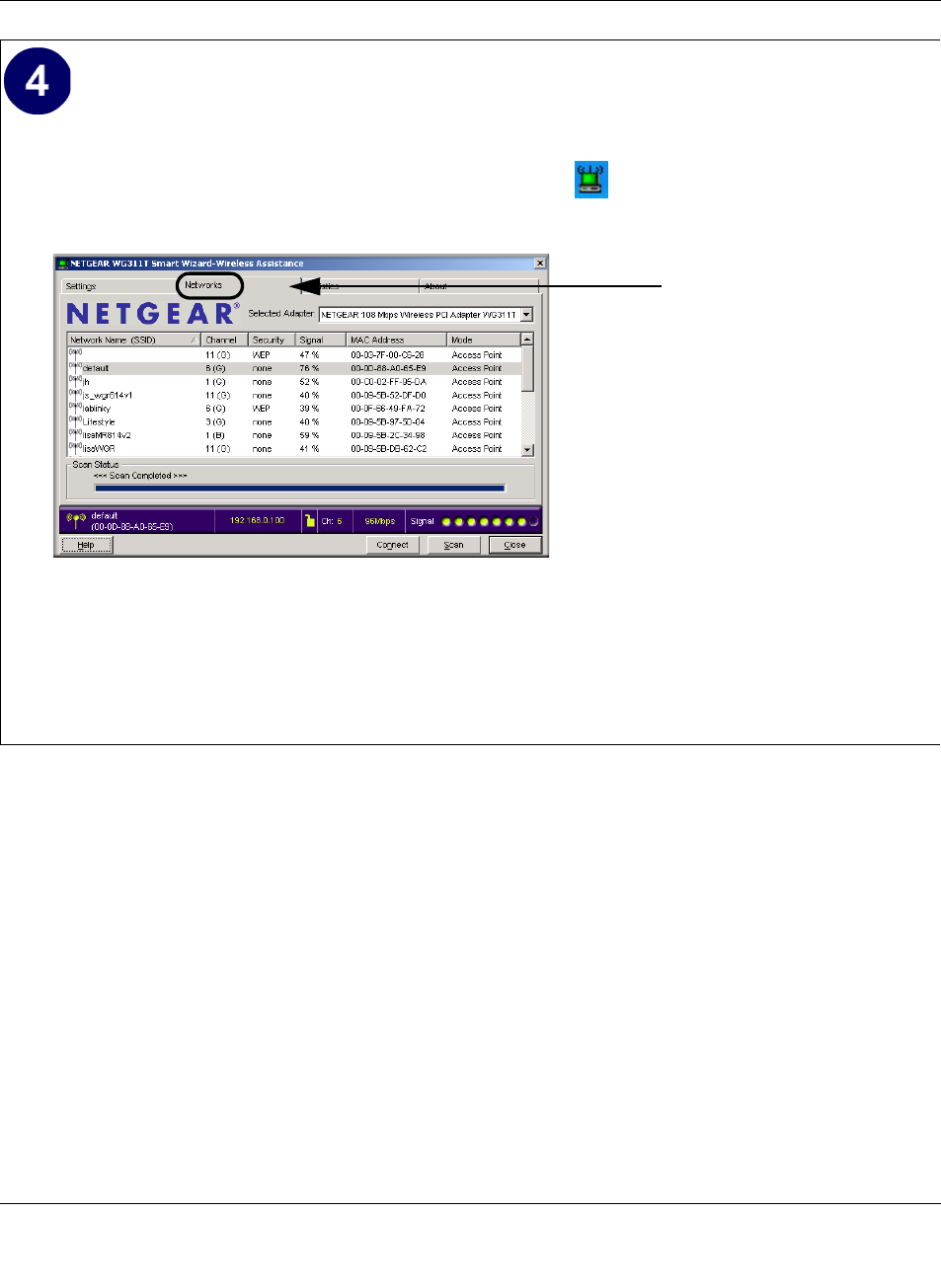
Installation Guide for the NETGEAR 108 Mbps Wireless PCI Adapter WG311T
Basic Setup 2-7
Verify wireless connectivity to your network.
a. Open the WG311T utility by clicking on the icon in the Windows system tray.
b. Verify connectivity to the Internet or network resources.
Note: If you are unable to connect, see “Basic Troubleshooting Tips” on page 2-13.
Note: You can use the Networks tab
to verify the availability of wireless
networks and their SSIDs.
For more information, see
“Understanding the Configuration
Options” on page 3-1.
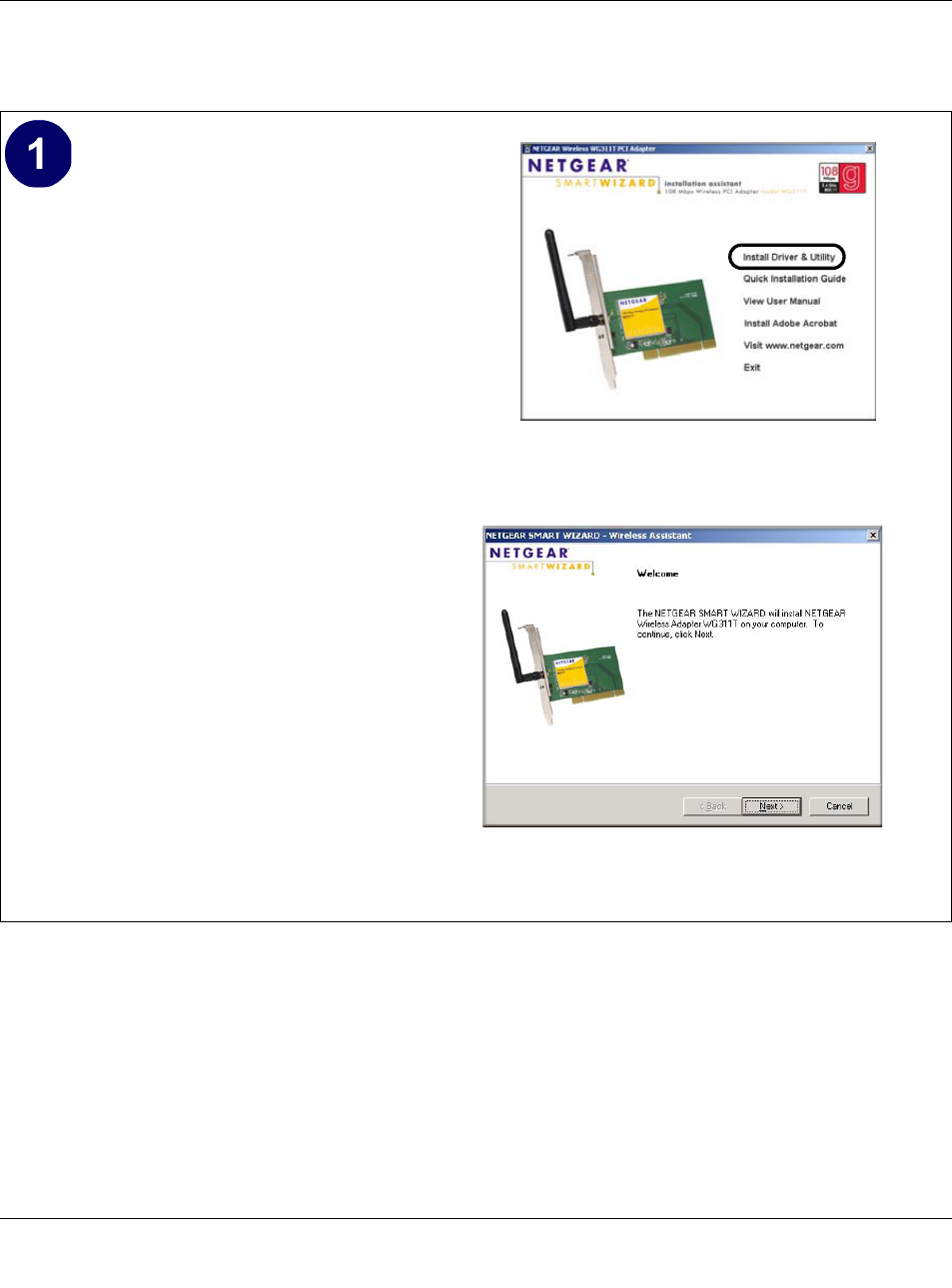
Installation Guide for the NETGEAR 108 Mbps Wireless PCI Adapter WG311T
2-8 Basic Setup
For Windows 2000 & 98SE/Me Users Installing a WG311T
Install the WG311T software.
Note: Windows 2000 may require you to be
logged on with administrator rights.
a. Power on your computer, let the
operating system boot up completely,
and log in as needed.
b. Insert the Resource CD for the WG311T
into your CD-ROM drive. The CD main
page shown at the right will load.
c. Click the “Install Driver & Utility” link.
d. Follow the Smart Wizard - Install
Assistant steps, and click Finish when
done to restart your computer.
Note: If you are prompted to restart your
computer, choose instead to shut it down.
This will let you install the WG311T before
restarting. Windows will find the new
hardware and can use the software you
installed.
WG311T Resource CD
Smart Wizard - Install Assistant

Installation Guide for the NETGEAR 108 Mbps Wireless PCI Adapter WG311T
Basic Setup 2-9
Install the NETGEAR 108 Mbps Wireless
PCI Adapter WG311T.
a. Shut down the PC and remove the power
cord. Insert the WG311T Wireless PCI
Adapter into an available PCI slot.
b. Reconnect the power cord and reboot the
computer. After a short delay, the Found
New Hardware Wizard displays.
c. You will be prompted to choose the
country where you are located. Select
your location from the list.
d. Click Next and follow the prompts to
proceed. After the installation
completes, click Finish to close the
wizard.
You should see the WG311T system tray
icon on the lower right portion of the
Windows task bar.
Add New Hardware Wizard
Note: If Windows displays a Digital Signature Not
Found warning, click Yes to continue.
WG311T System Tray Icon
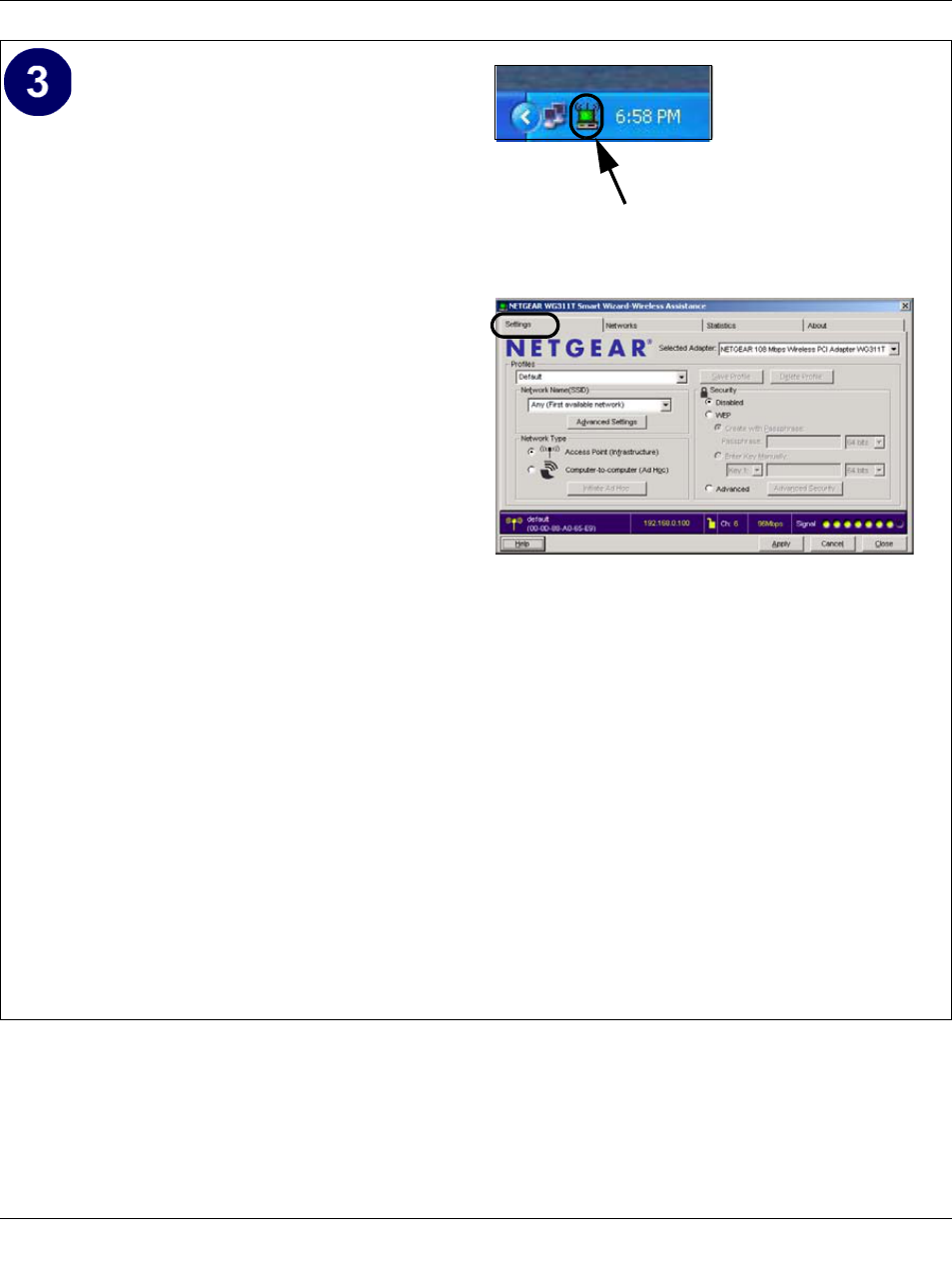
Installation Guide for the NETGEAR 108 Mbps Wireless PCI Adapter WG311T
2-10 Basic Setup
Configure your WG311T and save the
Profile.
a. Open the WG311T Smart Wireless
Configuration Utility by clicking on the
icon in the Windows system tray. The
utility opens to the Settings page.
b. Change the Network Name SSID to
match your network.
Tip: As an alternative to typing in the
SSID, you can use the Network tab to
view the available wireless networks.
Double-click on the desired network.
c. Click the Apply button to activate the
connection.
d. Enter a name for your profile and click
the Save Profile button to store the
current settings.
Tip: If you use your notebook PC to
connect to a wireless network at work
and at home, create profiles called work
and home.
Note: This procedure assumes you are
connecting to a wireless network which is not
using WEP security. If your network includes
WEP settings, enter the security information
in the Security section. For help with these
steps, see “Enabling Wireless Security
Features” on page 3-8.
WG311T system tray icon
WG311T Configuration Utility
Note: The NETGEAR default settings are
Infrastructure mode, with ANY for the wireless
network name SSID, and WEP disabled.
Click here to open the configuration utility.
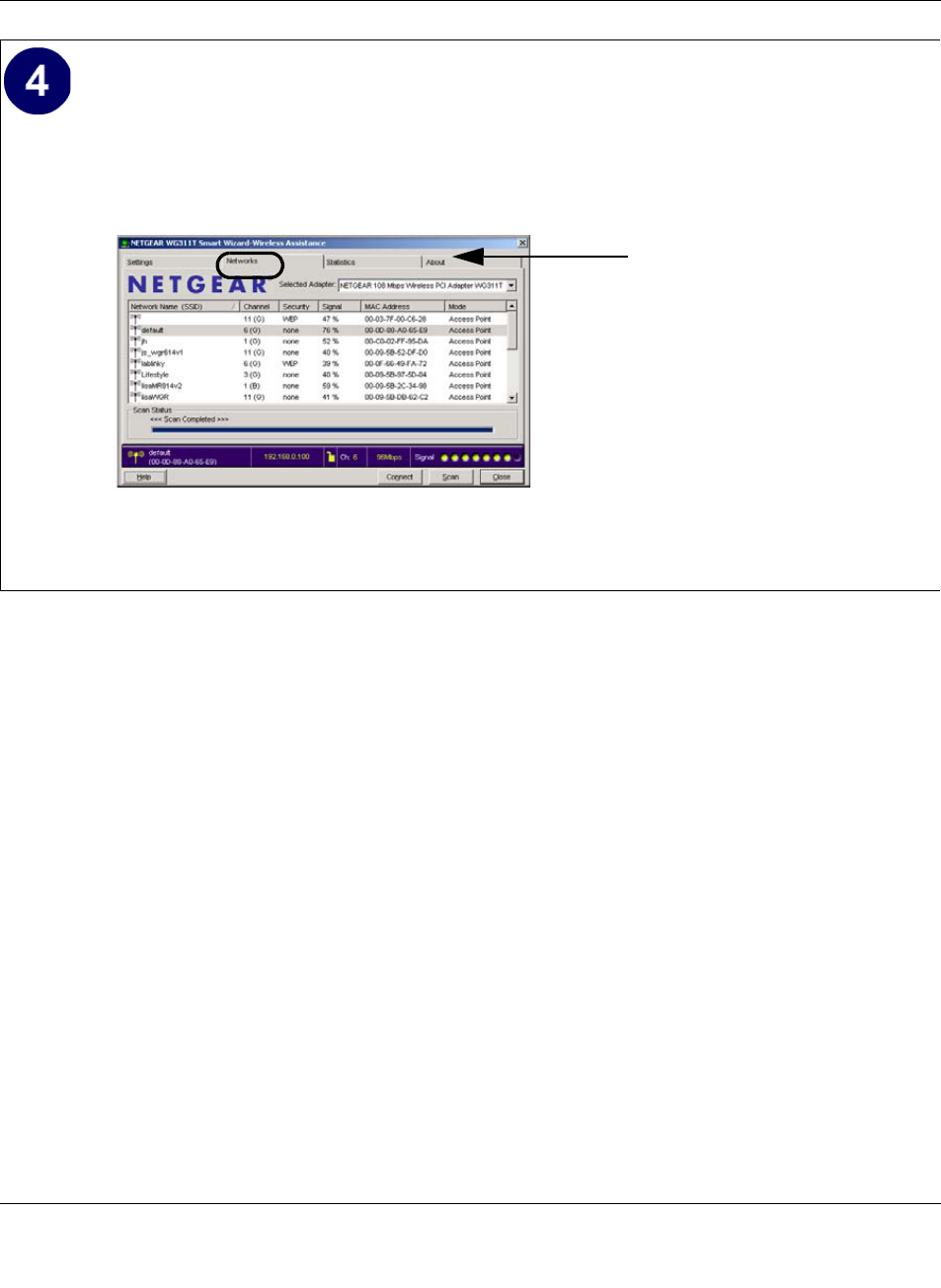
Installation Guide for the NETGEAR 108 Mbps Wireless PCI Adapter WG311T
Basic Setup 2-11
Verify wireless connectivity to your network.
a. Verify that your connection information matches your wireless network.
b. Verify connectivity to the Internet or network resources.
Note: If you are unable to connect, see “Basic Troubleshooting Tips” on page 2-13.
Note: You can use the Networks
tab to verify the availability of
wireless networks and their SSIDs.
For more information, see
“Understanding the Configuration
Options” on page 3-1.

Installation Guide for the NETGEAR 108 Mbps Wireless PCI Adapter WG311T
2-12 Basic Setup
WG311T Wireless Connection Indicators
The NETGEAR 108 Mbps Wireless PCI Adapter WG311T SysTray icon, which is on the System
Tray portion of the taskbar in the Microsoft Windows desktop, is an indicator that gives you
feedback on the status of your wireless connection. The color of the SysTray icon indicates the
status of the connection.
Interpreting System Tray Icon Colors
The System Tray (SysTray) resides on one end of the taskbar in the Microsoft Windows desktop.
Color Condition Description
Red The wireless PCI Adapter
has no connection to any
other wireless node.
The wireless PCI Adapter is not able to link to any
other wireless node or the link is lost. Check your
configuration or try moving to a location where the
wireless signal quality is better.
Yellow The wireless PCI Adapter
has a connection with
another wireless node.
The wireless link is weak. You may deed to move to a
better spot, such as closer to the wireless access point.
Also, look for possible interference such as a 2.4 GHz
cordless phone or large metal surface.
Green The wireless PCI Adapter
has a connection with
another wireless node.
The wireless PCI Adapter has established good
communication with an access point and the signal
quality is strong.

Installation Guide for the NETGEAR 108 Mbps Wireless PCI Adapter WG311T
Basic Setup 2-13
Basic Troubleshooting Tips
If you have problems connecting to your wireless network, try the tips below. If this does not solve
the problem, see “Frequently Asked Questions” on page 4-1.
Also, for problems with accessing network resources, the Windows software might not be installed
and configured properly on your computers. Please refer to Appendix C, “Preparing Your PCs for
Network Access” of the Reference Manual on the NETGEAR 108 Mbps Wireless PCI Adapter
WG311T Resource CD.
Symptom Cause Solution
I can connect to
an access point,
but I cannot
connect to other
computers on
the network or
the Internet.
This could be a
physical layer
problem or a
network
configuration
problem.
Check to make sure that the access point is physically
connected to the Ethernet network.
Make sure that the IP addresses and the Windows
networking parameters are all configured correctly.
Restart the cable or DSL modem, router, access point,
and notebook PC.
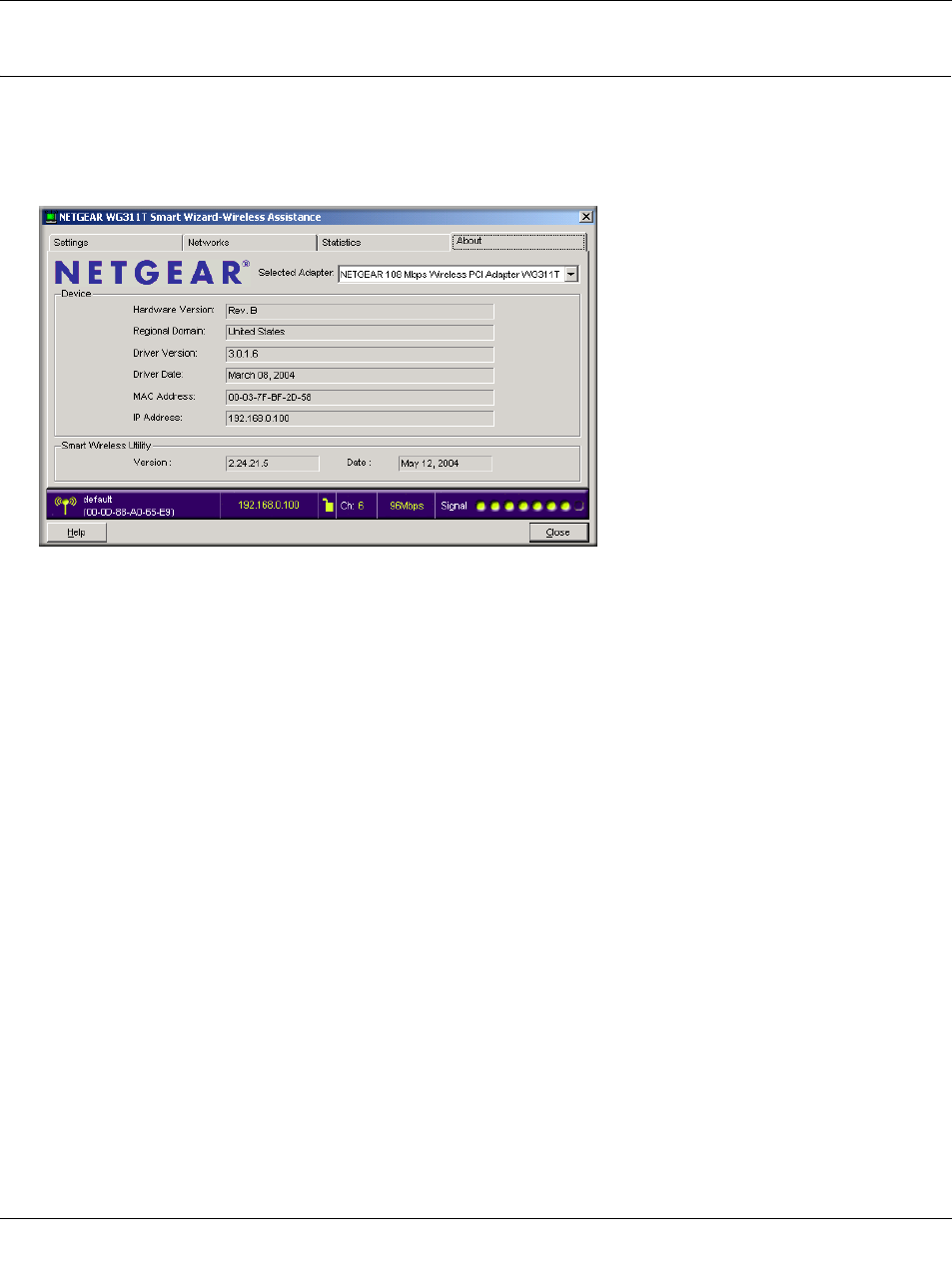
Installation Guide for the NETGEAR 108 Mbps Wireless PCI Adapter WG311T
2-14 Basic Setup
About Page
The About page displays important information about the NETGEAR 108 Mbps Wireless PCI
Adapter WG311T.
Figure 2-1: About page
The About page shows the following information:
•Regional Domain: This is the region setting for the wireless adapter. The approved channels
for this region are automatically scanned. Governments regulate the channels used for wireless
transmission. Operating the wireless adapter in a different region may violate local laws.
•Driver Version: The wireless adapter driver version.
•Driver Date: The wireless adapter driver release date.
•MAC Address: The MAC address of this adapter. The Media Access Control address is a
unique 48-bit hardware address assigned to every network interface card. Some wireless
networks will restrict access based on a list of known MAC addresses. If you are
communicating with such a network, you would have to provide the address shown here to the
network administrator before you would be allowed to connect. Restricting access by MAC
address adds an obstacle against unwanted access to your network. However, unless you use
data encryption security, the data broadcast over the wireless link is fully exposed.
•IP Address: The IP address assigned to this adapter.
•Configuration Utility Software: The version and release date of this utility.

Configuration 3-1
Chapter 3
Configuration
This section describes how to configure your NETGEAR 108 Mbps Wireless PCI Adapter
WG311T for wireless connectivity on your Wireless Local Area Network (WLAN) and use the
data security encryption features.
Understanding the Configuration Options
The WG311T configuration utility provides a complete and easy to use set of tools to:
• Configure wireless settings.
• Monitor wireless network connections.
• Save your settings in configuration profiles.
The section below introduces these capabilities of the configuration utility.
Using Configuration Profiles
The WG311T configuration utility uses profiles to store all the configuration settings for a
particular wireless network. You can store multiple profiles and recall the one which matches
the network you want to join.
Note: The instructions in this section refer to the NETGEAR WG311T configuration
utility. Windows XP users must first disable the Windows XP configuration utility.
Open the network connections from the system tray icon, click the Properties button,
click the Wireless Networks tab and then clear the “Use Windows to configure my
wireless network settings” check box.
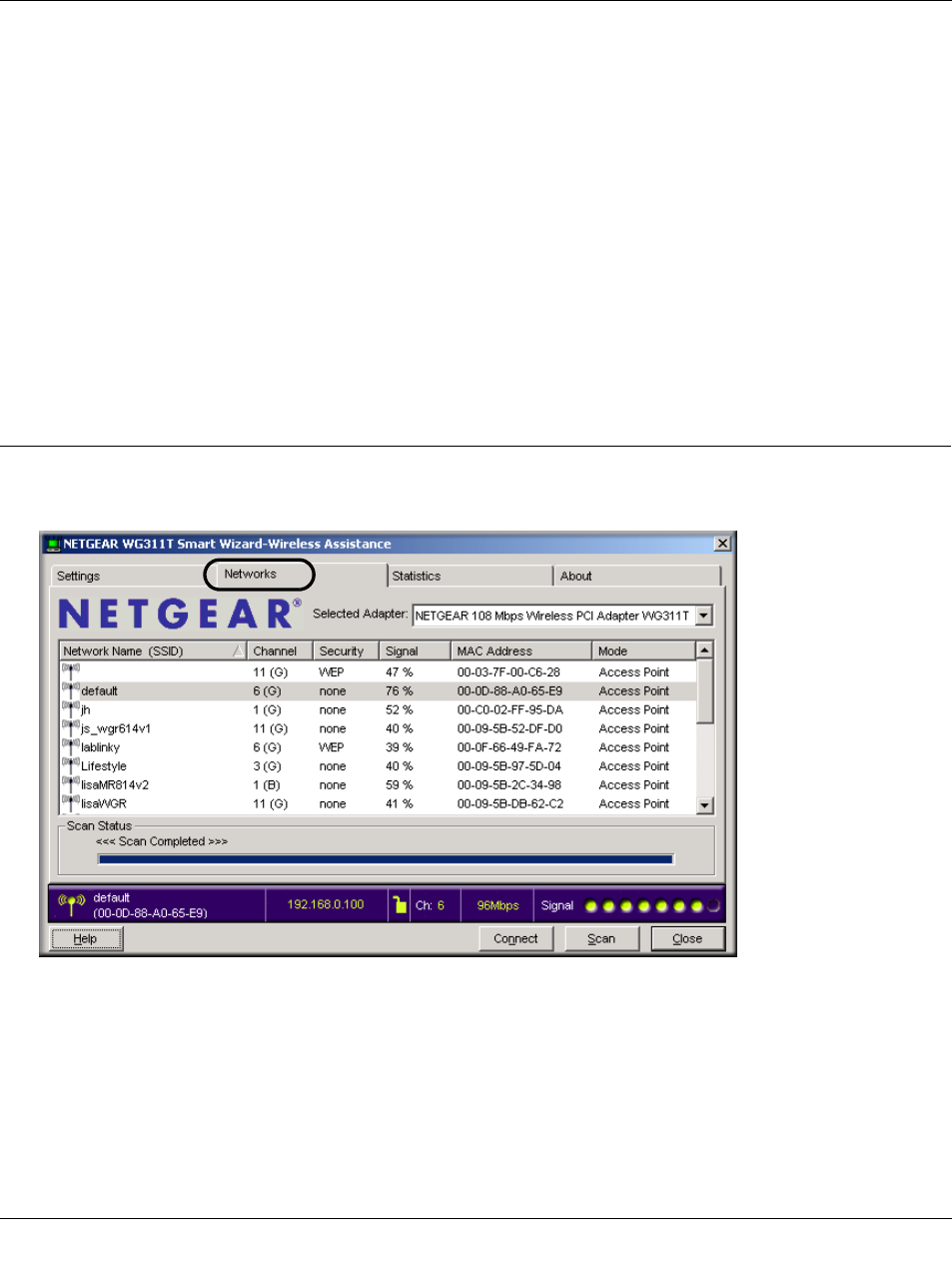
Installation Guide for the NETGEAR 108 Mbps Wireless PCI Adapter WG311T
3-2 Configuration
For example, if you use your PC to connect to a wireless network in an office and a wireless
network in your home, you can create a profile for each wireless network. Then, you can easily
load the profile that has all the configuration settings you need to join the network you are using at
the time.
There are two types of wireless network connections you can configure:
•Infrastructure Mode — uses the 802.11 infrastructure mode.
•Ad-Hoc Mode — uses the 802.11 ad-hoc mode
For more information on 802.11 wireless network modes, see “Wireless Networking Overview”
on page B-1 of this manual.
Networks Page
The Networks page shows the available networks at your location.
Figure 3-1: Networks tab page
The Networks page displays the following fields:

Installation Guide for the NETGEAR 108 Mbps Wireless PCI Adapter WG311T
Configuration 3-3
•Wireless Network Name (SSID): Wireless Network Name (SSID) is the name assigned to a
wireless network. This is the same as the SSID or ESSID configuration parameter. Note that,
as a security measure, some wireless access points do not broadcast their SSID. In such cases,
the SSID field will be blank even though the rest of the information will still be displayed.
•Channel: The channel determines which operating frequency will be used.
•Security: Identifies if the wireless network requires WEP or Advanced/WPA-PSK security
settings.
•Signal: Identifies the signal strength of the communications.
•MAC Address: Identifies the hardware address (MAC Address) of the wireless device
broadcasting this information.
•Mode: Identifies the type of wireless network — Access Point (Infrastructure) or
Computer-to-computer (Ad-Hoc).
To connect to a network:
1. Click Scan to view the available networks.
2. Click on the column header to sort for better viewing if you have many networks.
3. Double-click to connect to the SSID.
4. The highlighted SSID is the one currently connected.
Connecting to an Access Point in Infrastructure Mode
This section provides instructions for configuring the NETGEAR 108 Mbps Wireless PCI Adapter
WG311T to connect to a wireless access point.
How to Configure an Infrastructure Mode Profile
Follow the instructions below to configure an infrastructure mode profile for connecting to an
access point.
1. Run the WG311T Configuration Utility.
a. Open the configuration utility by clicking on the WG311T icon in the Windows
system tray.
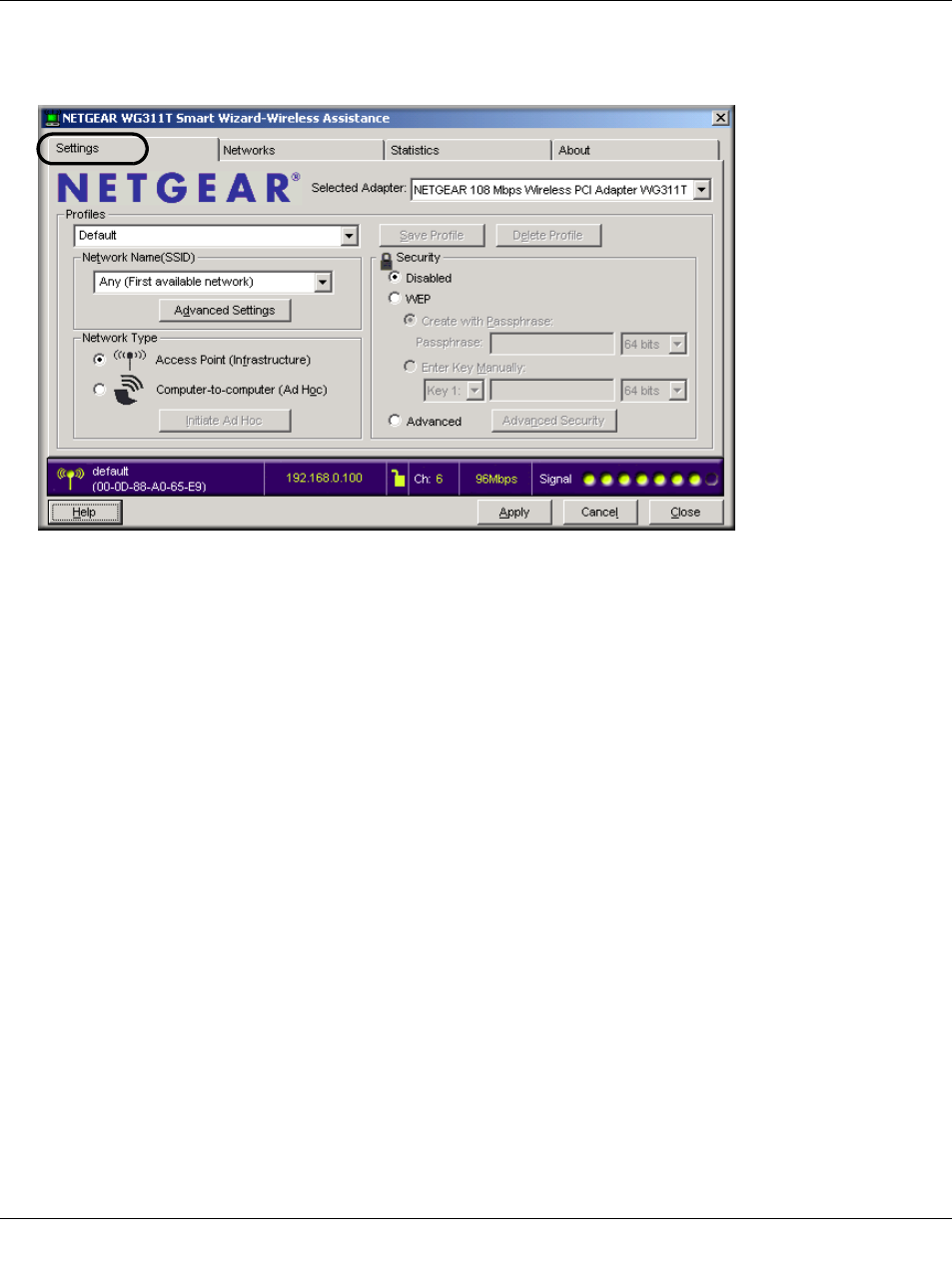
Installation Guide for the NETGEAR 108 Mbps Wireless PCI Adapter WG311T
3-4 Configuration
b. Click on the Settings tab to display the view shown below.
Figure 3-2: Settings tab page
2. Configure the wireless Network settings.
a. In the Network Type section, be sure that Infrastructure is selected.
b. Enter the SSID. This is also called the Wireless Network Name.
Note: You will not get a wireless network connection unless the network SSID matches
exactly what is configured in the access point.
Tip: You can click the Networks tab to view a list of the available wireless networks and
their SSIDs at your location.
3. Save your settings in a Profile.
a. Type a descriptive name for the Profile in the “Profiles” name field.
b. Click Save Profile. All the configuration settings are saved in this profile.
c. Click Apply.
d. Click Close to exit the configuration utility or Cancel to return to the previous settings.
4. Verify wireless connectivity to your network.

Installation Guide for the NETGEAR 108 Mbps Wireless PCI Adapter WG311T
Configuration 3-5
Verify connectivity by using a browser such as Netscape or Internet Explorer to connect to the
Internet, or check for file and printer access on your network.
You can check the status bar in the configuration utility for the current connection status.
Note: If you cannot connect, see the “Basic Troubleshooting Tips” on page 2-13. Also, if you
have problems accessing network resources, the Windows Client and File and Print Sharing
software might not be installed and configured properly on your computers. Please refer to
“Preparing Your Computers for TCP/IP Networking” on page C-1.
Connecting to Another PC in Ad-Hoc Mode
The computer-to-computer setting of the WG311T uses Ad-Hoc mode. Ad-Hoc mode is an 802.11
networking framework in which devices or computers communicate directly with each other,
without the use of an access point. For example, this mode is used when two Windows computers
are configured with file and print sharing enabled and you want to exchange files directly between
them.
How to Configure an Ad-Hoc Mode Profile
Note: Ad-Hoc mode will not work using DHCP settings. Ad-Hoc mode requires either static IP
addresses (such as 192.168.0.1) or other appropriate Windows networking configuration
parameters such as adding IPX protocol support. For instructions on setting up static IP addresses
or IPX protocol settings on a Windows PC, refer to the PC Networking Tutorial included on the
NETGEAR 108 Mbps Wireless PCI Adapter WG311T Resource CD.
Follow the instructions below to configure an Ad-Hoc mode profile.
1. Run the WG311T Configuration Utility.
a. Open the configuration utility by clicking on the WG311T icon in the Windows
system tray.
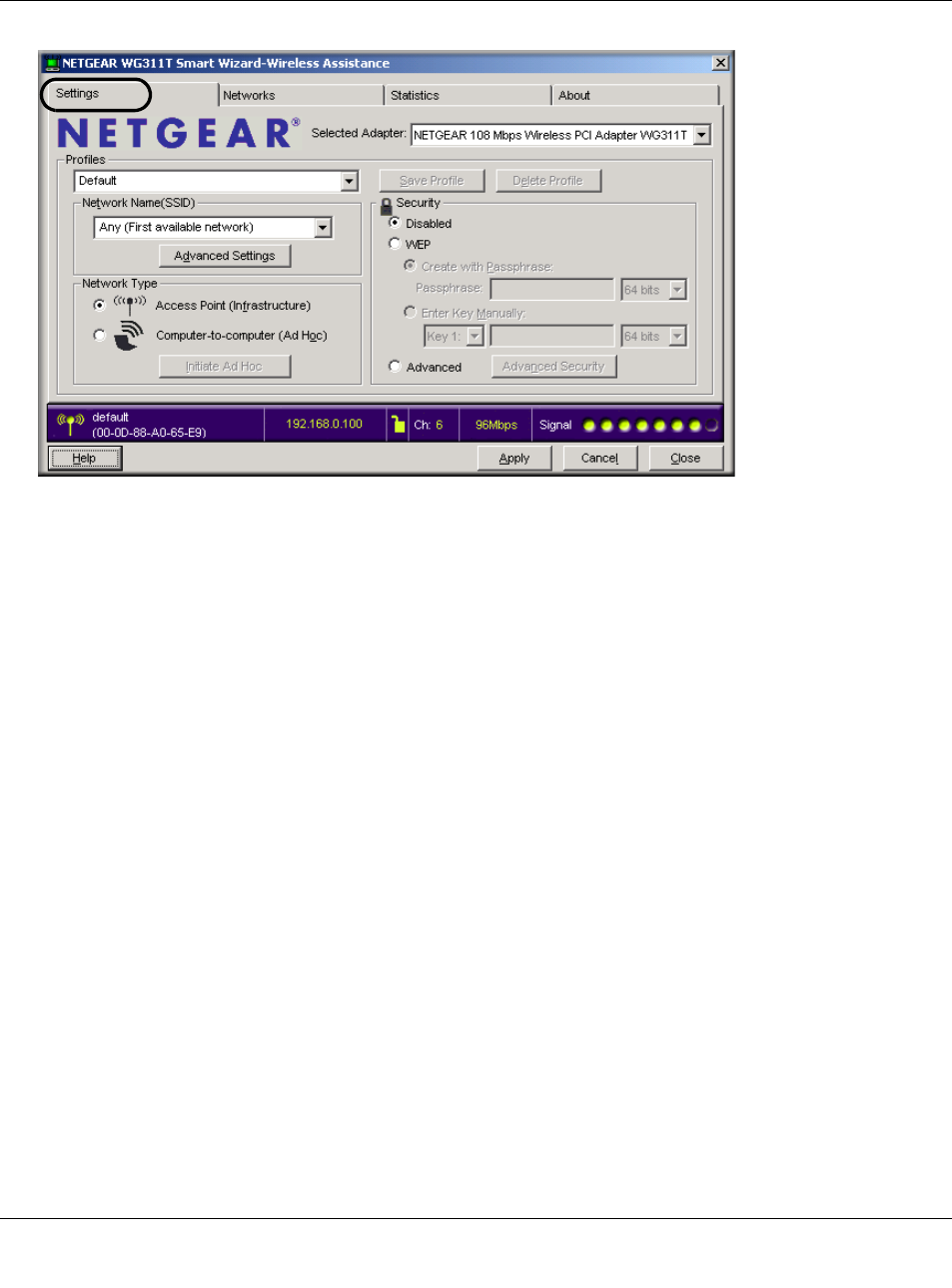
Installation Guide for the NETGEAR 108 Mbps Wireless PCI Adapter WG311T
3-6 Configuration
Figure 3-3: Settings tab page
b. Click the Settings tab to display the view shown above.
c. Select Ad-Hoc in the Network Type section.
d. Enter the SSID for the Ad-Hoc network.
e. Click Apply.
2. Save your settings in a Profile.
a. Type a descriptive name for the Profile Name.
b. Click Save Profile. All the configuration settings are saved in this profile.
c. Click Apply.
d. Click Close to exit the configuration utility.
3. Configure the PC network settings.
a. Configure each PC with either a static IP address or with the IPX protocol.
Note: For instructions on configuring static IP addresses or the IPX protocol, refer to the
networking tutorial on your NETGEAR 108 Mbps Wireless PCI Adapter WG311T
Resource CD.
b. Restart the PCs.
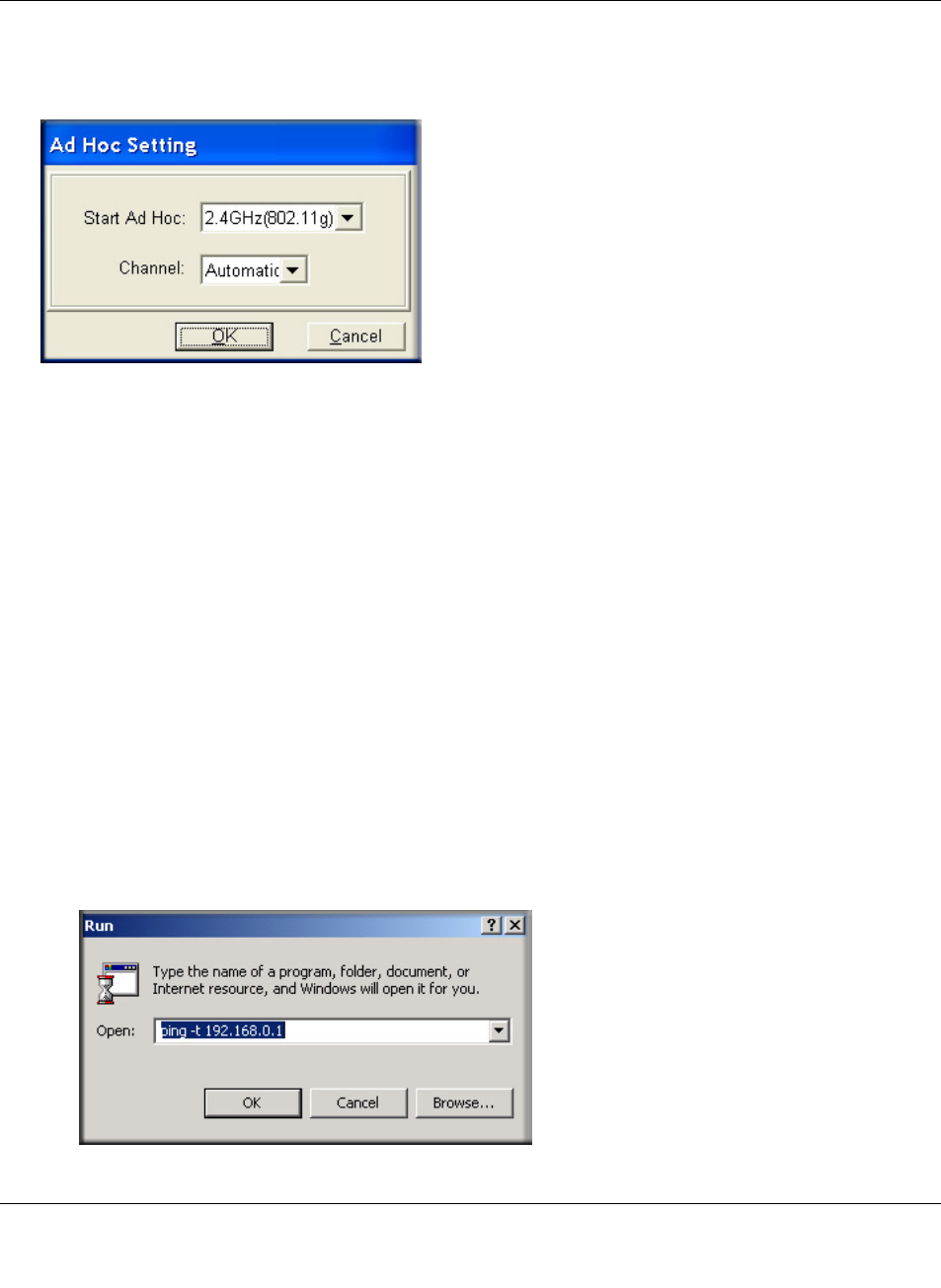
Installation Guide for the NETGEAR 108 Mbps Wireless PCI Adapter WG311T
Configuration 3-7
4. Click Initiate Ad-Hoc.
The Ad-Hoc Setting dialog box will appear, as shown below.
Figure 3-4: Ad-Hoc Setting page
a. The supported wireless standard is 802.11b/g for your Ad-Hoc computer-to-computer
network.
b. In the Channel field, Automatic should work. If you notice interference problems with
another nearby wireless device, select a channel that is not being used by any other
wireless networks near your wireless adapter. Use the Networks tab page to identify the
channels in use in your area.
The channel number differs depending on the country. The connection speed
automatically defaults to the highest speed.
c. Click OK.
5. Verify wireless connectivity between your peer devices.
Verify connectivity by using the Ping program:
a. On the Windows taskbar click the Start button, and then click Run.
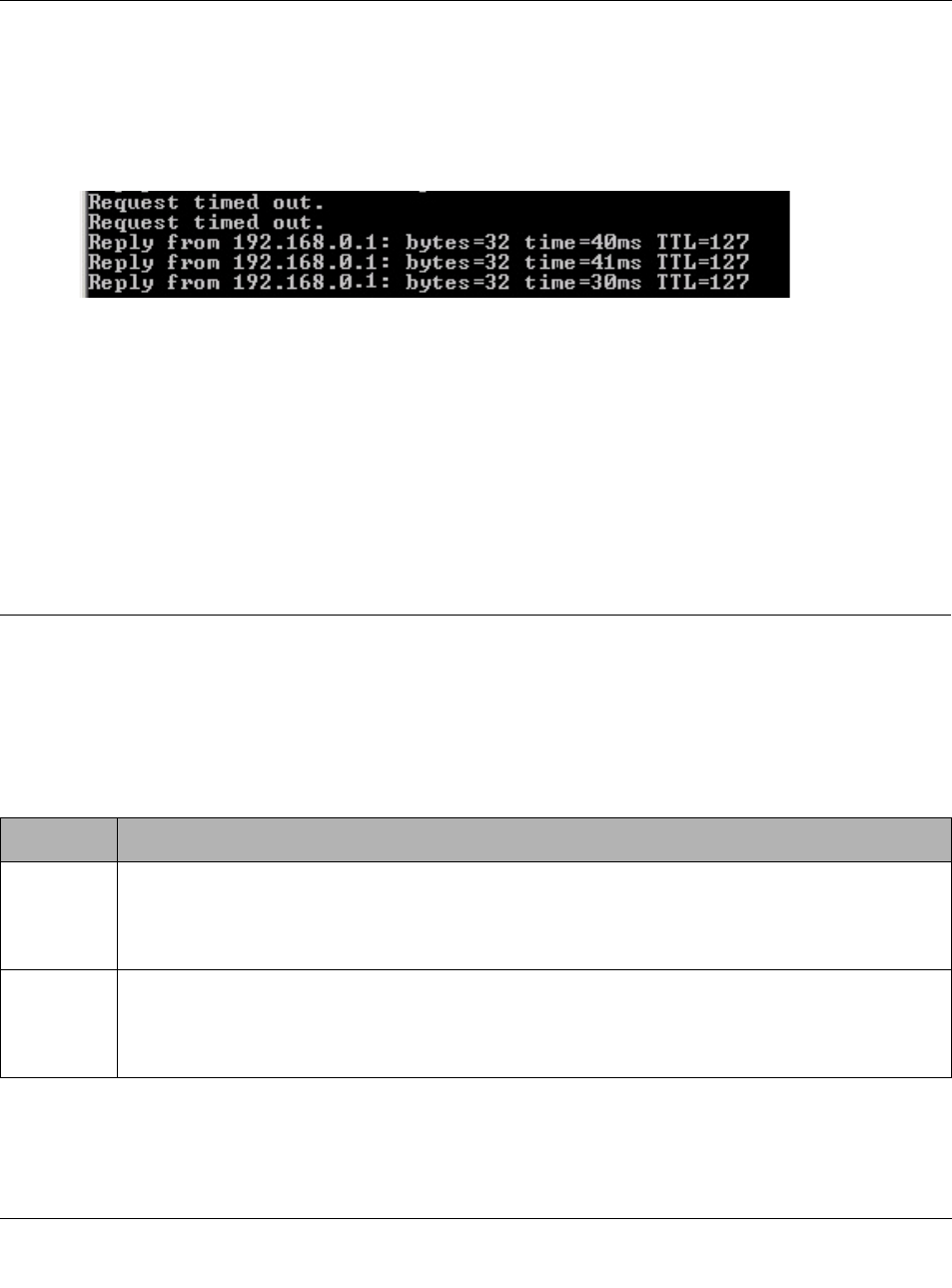
Installation Guide for the NETGEAR 108 Mbps Wireless PCI Adapter WG311T
3-8 Configuration
b. Assuming the target PC is configured with 192.168.0.1 as its IP address, type ping -t
192.168.0.1 and then click OK.
c. This will cause a continuous ping to be sent to the device with the 192.168.0.1 static IP
address. The ping response should change to “reply.”
At this point the connection is established.
You may need to reboot in certain Windows operating systems such as Windows 98SE.
Note: If you cannot connect, see “Basic Troubleshooting Tips” on page 2-13. Also, if you
have problems accessing network resources, the Windows Client and File and Print Sharing
software might not be installed and configured properly on your computers. Please refer to
“Preparing Your Computers for TCP/IP Networking” on page C-1.
Enabling Wireless Security Features
You can strengthen the security of your wireless connection by enabling encryption of the wireless
data communications. This table summarizes the available security options of your NETGEAR
108 Mbps Wireless PCI Adapter WG311T.
For more information on 802.11 wireless security, see Appendix B, “Wireless Networking Basics.
The procedures below identify how to configure the encryption settings of your NETGEAR 108
Mbps Wireless PCI Adapter WG311T.
Table 3-1. Wireless Security Options
Field Description
WEP WEP offers the following options: 64- or 128-bit WEP Data Encryption.
Choose the Encryption Strength (64- or 128-bit data encryption). Manually enter the key
values or enter a word or group of printable characters in the Passphrase box. Manually
entered keys are case sensitive but passphrase characters are not case sensitive.
WPA-PSK WPA-Pre-shared Key , uses 128-bit data encryption and dynamically changes the encryption
keys making it nearly impossible to circumvent.
Enter a word or group of printable characters in the Password Phrase box. These characters
are case sensitive.

Installation Guide for the NETGEAR 108 Mbps Wireless PCI Adapter WG311T
Configuration 3-9
Identifying the Wireless Security Settings
Print this form, fill in the configuration parameters and put it in a safe place for possible future
reference. For an existing wireless network, the person who set up the network will be able to
provide this information.
•Wireless Network Name (SSID): The Service Set Identification (SSID) identifies the wireless
local area network. ANY is the default WG311T wireless network name (SSID). You can
customize it using up to 32 alphanumeric characters. Write your customized wireless network
name (SSID) on the line below.
Note: The SSID in the wireless access point is the SSID you configure in the wireless pc
adapter. For the access point and wireless nodes to communicate with each other, all must be
configured with the same SSID.
Wireless network name (SSID): ______________________________
•If WEP Authentication is Used.
–WEP Encryption key size. Identify one: 64-bit or 128-bit. The encryption key size must
the wireless network settings.
–Data Encryption (WEP) Keys. There are two methods for creating WEP data encryption
keys. Whichever method you use, record the key values in the spaces below.
•Passphrase method. ______________________________ These characters are case
sensitive. Enter a word or group of printable characters and click the Generate Keys
button. Not all wireless devices support the passphrase method.
•Manual method. These values are not case sensitive. For 64-bit WEP, enter 10 hex
digits (any combination of 0-9 or a-f). For 128-bit WEP, enter 26 hex digits.
Key 1: ___________________________________
Key 2: ___________________________________
Key 3: ___________________________________
Key 4: ___________________________________
•If WPA-PSK Authentication is Used.
–Passphrase: ______________________________ These characters are case sensitive.
Enter a word or group of printable characters. When you use WPA-PSK, the other devices
in the network will not connect unless they are set to WPA-PSK as well and are configured
with the correct Passphrase.
Use the procedures below to configure basic security settings in the WG311T.
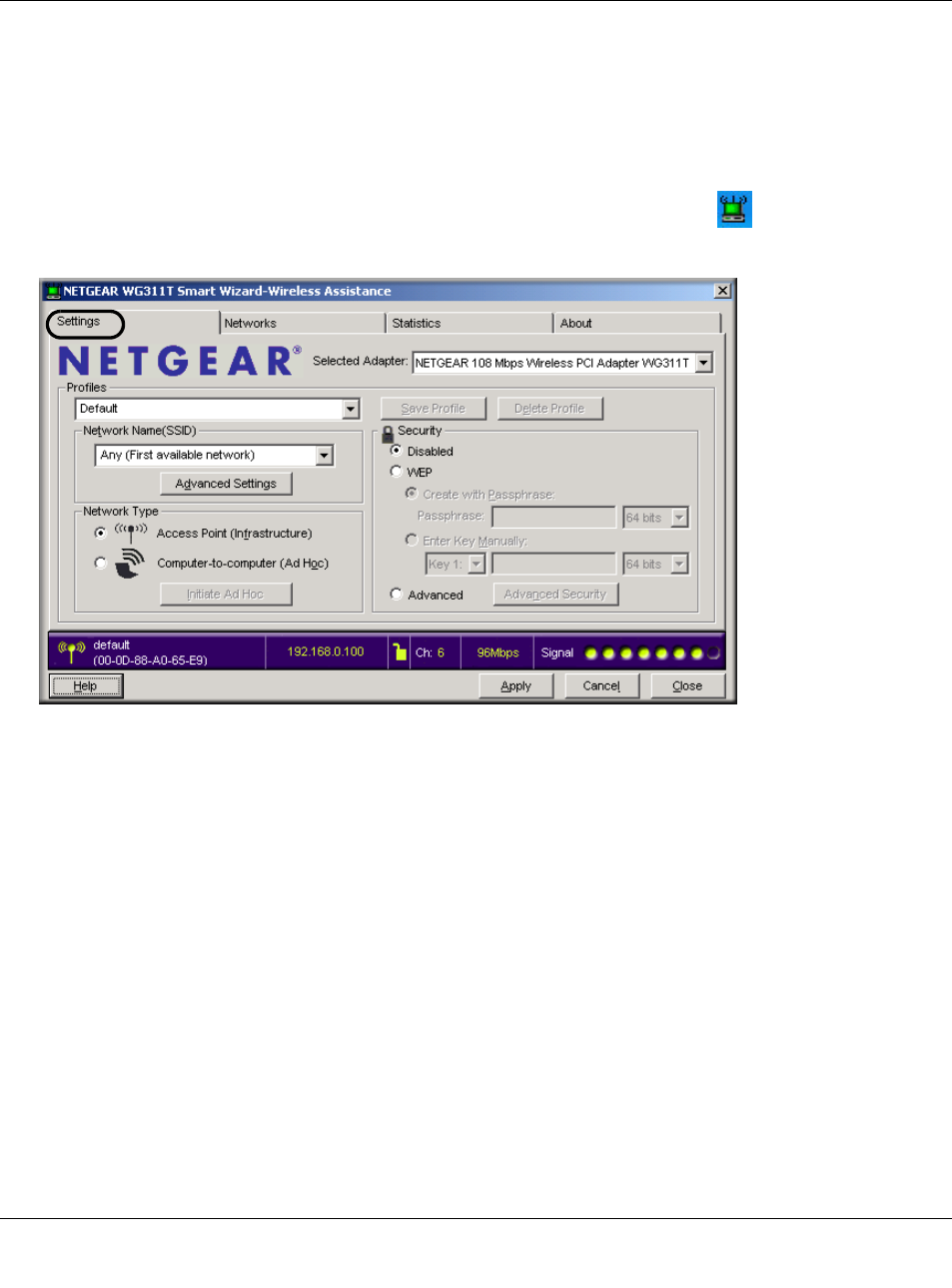
Installation Guide for the NETGEAR 108 Mbps Wireless PCI Adapter WG311T
3-10 Configuration
How to Configure WEP Encryption Security
Following the steps below to configure WEP Encryption Security.
1. Run the WG311T Configuration Utility.
a. Open the configuration utility by clicking on the WG311T icon in the Windows
system tray.
Figure 3-5: Settings tab page
b. Click on the Settings tab to display the view shown above.
2. Configure the Security settings.
a. Select the Use WEP Encryption check box.
b. Enter the SSID. This is also called the Wireless Network Name.
Note: You will not get a wireless network connection unless the network SSID matches
exactly what is configured in the access point.
Tip: You can click the Networks tab to view a list of the available wireless networks and
their SSIDs at your location.

Installation Guide for the NETGEAR 108 Mbps Wireless PCI Adapter WG311T
Configuration 3-11
3. Save your settings in a Profile.
a. Type a descriptive name for the Profile name.
b. Click Save Profile. All the configuration settings are saved in this profile.
c. Click Apply.
d. Click Close to exit the configuration utility.
4. Select the WEP encryption strength you will use.
The choices are:
• 64-bit WEP data encryption
• 128-bit WEP data encryption
Note: Larger encryption keys require more processing and may slow the communications
response times.
a. Select Create with Passphrase and enter the passphrase. The configuration utility will
automatically generate the WEP keys.
Note: The characters are case sensitive. Be sure to use the same passphrase for all the
wireless devices in the network.
If the passphrase method is not available in the other devices, you must manually enter the
keys to match exactly what is in the access point and other 802.11 wireless devices.
b. The Default Key setting must match what is set in the access point and the other 802.11
wireless devices.
5. Click Apply for the changes to take effect.
How to Configure WPA-PSK Encryption Security
Wi-Fi Protected Access (WPA) is wireless security with far greater protection than WEP.
WPA-PSK (pre-shared key) uses encryption of a shared key as the starting point. WPA has a
significant advantages over WEP — an encryption key differing in every packet. It is extremely
difficult for hackers to read messages even if they have intercepted the data.
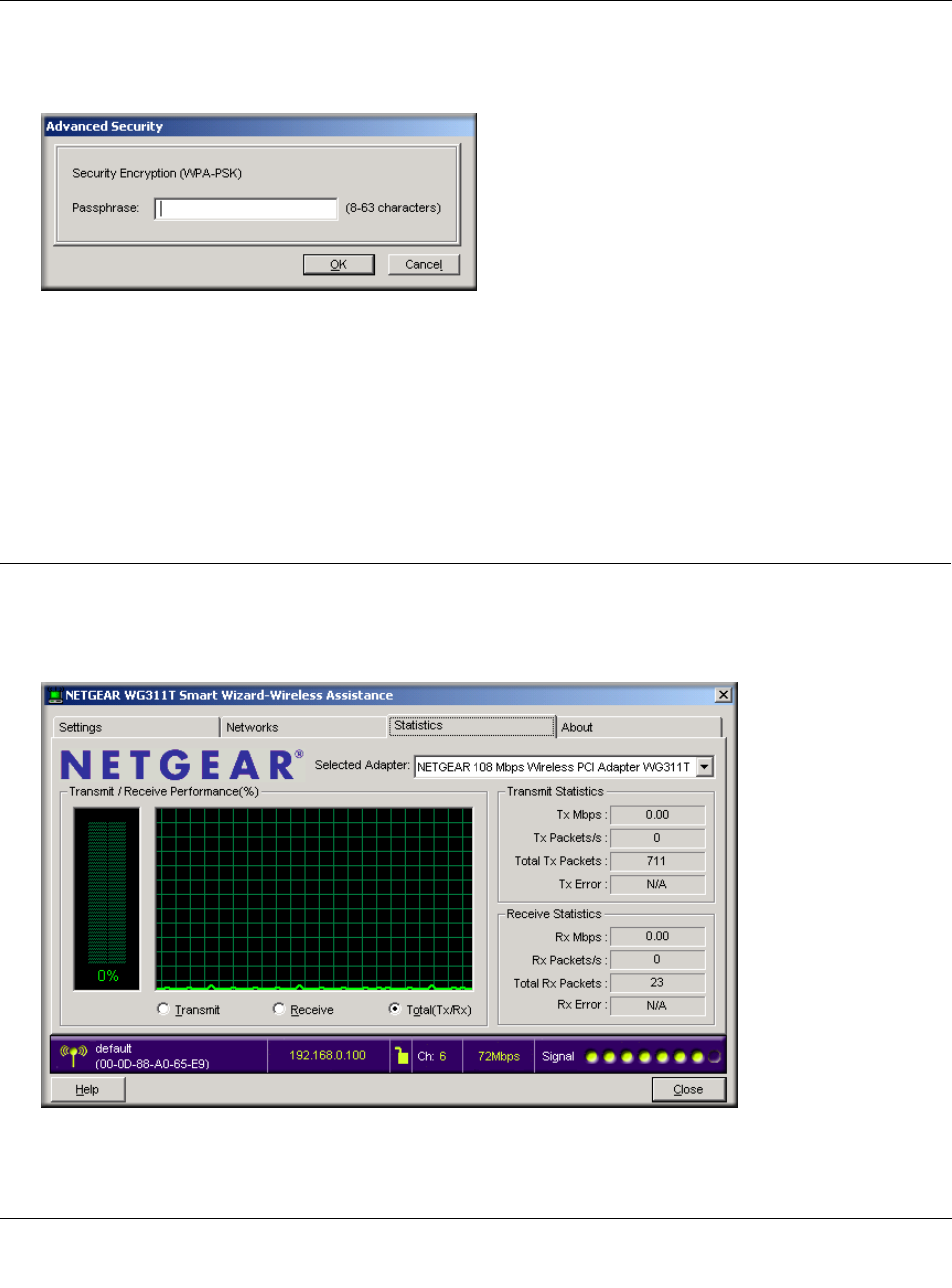
Installation Guide for the NETGEAR 108 Mbps Wireless PCI Adapter WG311T
3-12 Configuration
To configure WPA-PSK security, click the Advanced Security button. The Advanced Security
button is located in the Settings page, Security section.
Figure 3-6: Advanced Security page
The Passphrase can be between 8 and 63 characters
For more information on WPA security, see “WPA Wireless Security” on page B-8.
Statistics Page
The Statistics page provides real time and historical trend information on the data traffic and
performance of your wireless adapter.
Figure 3-7: Statistics tab page
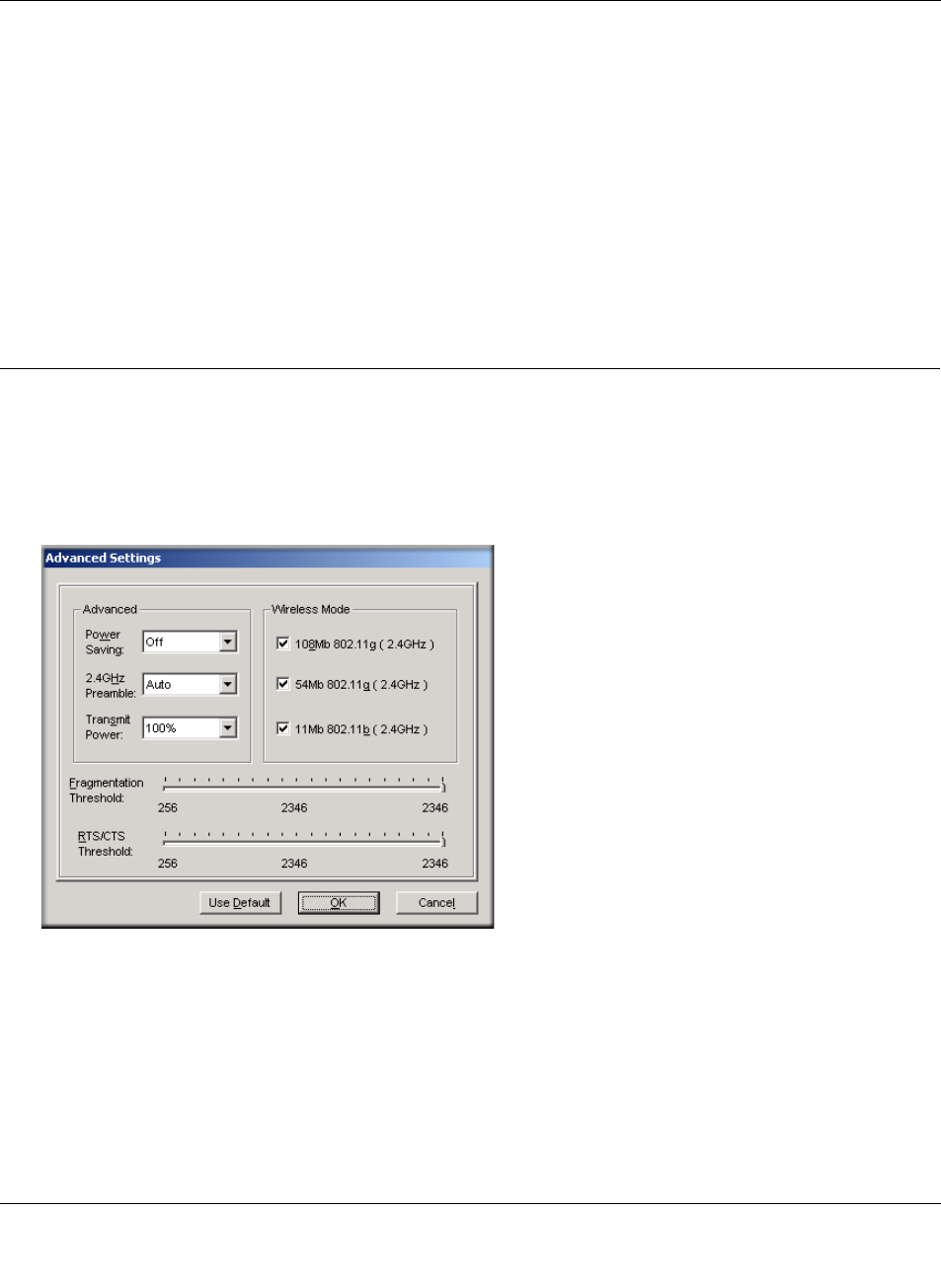
Installation Guide for the NETGEAR 108 Mbps Wireless PCI Adapter WG311T
Configuration 3-13
•Transmit/Receive Performance (%): A real time graph identifying the transmit, receive, or
total utilization as a percentage the total possible. The Transmit, Receive, and Total (TxRx)
radio buttons let you select whether to display the transmit performance, the receive
performance, or the total of both in the same graph. Total is the default.
•Transmit Statistics: Identifies Transmit megabits per second (Mbps), transmit packets per
second (Tx Packets/s), total transmitted packets, and transmit errors.
•Receive Statistics: Identifies Receive megabits per second (Mbps), receive packets per second
(Rx Packets/s), total received packets, and received errors.
Advanced Settings Page
Generally, the Advanced settings should not require adjustment. Except for the power saving
setting, changing any of the settings incorrectly on this page could cause your wireless connection
to fail.To display the Advanced Settings Page, click the Advanced Settings button on the Settings
Page.
Figure 3-8: Advanced Settings page
•Power Saving: Select On if you are using a notebook computer running on battery power.
•Preamble: A long transmit preamble may provide a more reliable connection or slightly
longer range. A short transmit preamble might give slightly better performance.

Installation Guide for the NETGEAR 108 Mbps Wireless PCI Adapter WG311T
3-14 Configuration
•Transmit Power: Lowering the output power level lets you reduce the chance of interference
with other nearby access points but reduces the range of your adapter.
•Wireless Mode: Select the wireless protocols you will use. Depending on your wireless
adapter, you can choose some or all of the available 802.11 wireless protocols. Note that, if the
wireless network you are communicating with uses the 108Mb Turbo mode, you must include
that in your selection.
•Fragmentation Threshold: This is the maximum packet size used for fragmentation. Packets
larger than the size programmed in this field will be fragmented. The Fragment Threshold
value must be larger than the RTS Threshold value.
•RTS/CTS Threshold: RTS is request to send and CTS is clear to send; their purpose is to
avoid collisions. RTS/CTS will be enabled if the data frame size is larger than the threshold
value set here. The maximum frame size is 2346 octets, so if the threshold is 2346, RTS/CTS
will be disabled.
Note: This setting is reserved for wireless testing and advanced configuration only. Do not
change this setting unless you are sure you need to. The primary reason for implementing
RTS/CTS is to minimize collisions between hidden stations. This occurs when users and
access points are spread out and a high number of retransmissions occur on the wireless LAN.

Troubleshooting 4-1
Chapter 4
Troubleshooting
This chapter provides information about troubleshooting your NETGEAR 108 Mbps Wireless PCI
Adapter WG311T. After each problem description, instructions are given to help you diagnose and
solve the problem.
Also, for problems with accessing network resources, the Windows software might not be installed
and configured properly on your computers. Please refer to Appendix C, “Preparing Your PCs for
Network Access” of the Reference Manual on the NETGEAR 108 Mbps Wireless PCI Adapter
WG311T Resource CD.
Frequently Asked Questions
Use the information below to solve common problems you may encounter. Also, please refer to the
knowledge base on the NETGEAR web site at www.netgear.com/support/main.asp.
General Questions
Why do I see no more than 54 Mbps on the Configuration Utility status line?
The product literature says the WG311T can operate at 108 Mbps. You are probably connecting to
a standard 802.11g network. If you use the NETGEAR WGT624 108 Mbps Wireless Firewall
Router or WG634U 108 Mbps Wireless Media Router, you will see network speeds up to 108
Mbps.
The WG311T Smart Configuration Utility keeps asking me to save my settings
This is because you have made changes to the settings and the utility is offering you the chance to
save the changes. If you want to avoid these Profile setting prompts, simply click Apply before
you close the utility program.

Installation Guide for the NETGEAR 108 Mbps Wireless PCI Adapter WG311T
4-2 Troubleshooting
Ad Hoc mode is not working correctly
You need to click the Initiate Ad Hoc button before you click Apply. Here is how you start an Ad
Hoc network:
1. Fill in the Network Name (SSID).
2. Select the Computer-to-Computer (Ad Hoc) Network Type.
3. Click Initiate Ad Hoc.
4. Accept the default settings or make your changes and click OK
5. Click Apply.
Note: Be sure all computers in your Ad Hoc network are configured with static IP addresses in the
same subnet.
How to know if the WG311T card has received a valid IP address from the Wireless
Router/AP
The easiest way is to open up the WG311T utility program and check the IP address in the About
page.
How to use XP’s own Wireless configuration utility that comes with Windows XP
The NETGEAR WG311T software is designed so that the user will be asked to choose one of the
utility programs during initial software installation. Be sure the WG311T is connected to the PC
and follow these instructions to change your selection.
1. Go to Control Panel and select Network Connections.
2. Right click on the connection and select Properties.
3. Click the Wireless Networks tab.
4. Select or clear the WG311T “Use Windows to configure my wireless network settings” check
box.
How to remove the WG311T utility and software
To remove the WG311T software, go to Windows Start > Programs > NETGEAR WG311T Smart
Wizard. Select Uninstall NETGEAR WG311T software.

Installation Guide for the NETGEAR 108 Mbps Wireless PCI Adapter WG311T
Troubleshooting 4-3
I cannot connect to the AP that I want from the Networks browser list
The access point is available and there is good signal strength. There are a few possibilities:
• If the access point (AP) is WPA-PSK protected, you will need to have the correct WPA-PSK
passphrase. Otherwise, the WG311T will still be connected to the previous access point and
you will not be able to change to the WPA-PSK access point.
• If the access point is WEP protected (either 64 or 128 bit encryption), you will be prompted to
enter the WEP encryption security information.
The WG311T is not getting an IP address
You probably upgraded your WG311T software and did not reboot your system.
To get an IP address assigned, you can either restart your computer or choose another access point
to connect to. If there are no additional access points for you to choose from, restart your system
and connect to your desired access point again.
Note: It does not usually help to shut down the utility or disable/enable the card.
Wi-Fi Protected Access (WPA) Questions
Why is my WG311T not connecting to my WPA router?
I thought I chose my WPA router in XP Zero Configuration’s Available networks and it is showing
other devices in the Preferred networks list, why is my WG311T not connecting to my WPA
router?
Check your Preferred networks and remove the other non-WPA devices from the list. Only leave
your WPA router in the list and try connecting again.
Why is the icon in the System Tray flashing Green to Red alternately?
I thought I got my WG311T WPA connection – a green icon in the SystemTray.
Although you have use XP zero configuration utility for your WPA settings, the open “Green-Red”
flashing icon indicates that you might have entered the incorrect WPA secret key. Assure that the
WPA settings are configured correctly on both the Radius Server and the Router. In addition, you
may also check the Radius’ port number on the Radius server and the router.

Installation Guide for the NETGEAR 108 Mbps Wireless PCI Adapter WG311T
4-4 Troubleshooting
How do I know that my WG311T WPA is working?
Try browsing an Internet site to see if your WPA router has an Internet connection. Or try pinging
the Radius server through the WPA router.
Why is the WAN port not working after configuring WPA?
I can ping the WPA router but there is no Internet connection. I know that the WAN port was not
working before my WPA connection.
One thing to check is the DHCP on the WPA router. Make sure the DHCP server or DHCP client
option is correctly set. You may also check the Radius server’s DHCP settings.
Note: For all WPA questions, please refer to Microsoft’s Help documentation for additional WPA
related information and how to configure WPA using Windows XP Zero configuration utility.

Technical Specifications A-1
Appendix A
Technical Specifications
This appendix provides technical specifications for the NETGEAR 108 Mbps Wireless PCI
Adapter WG311T.
Antennae Detachable antenna
Radio Data Rate 1, 2, 5.5, 6, 9, 12, 18, 24, 36, 48, 54, and 108 Mbps (Auto Rate Sensing)
Frequency 2.4GHz to 2.5GHz CCK and OFDM Modulation)
Emissions FCC, CE
Bus interface PCI
Provided drivers Microsoft Windows 98SE, 2000, Me, XP
Weight 40 g
LED Power, Activity
Operating Environment Operating temperature: 0 to 55 degrees C, 32 to 131 degrees F
Encryption 40-bit (also called 64-bit) and 128-bit WEP data encryption

Installation Guide for the NETGEAR 108 Mbps Wireless PCI Adapter WG311T
A-2 Technical Specifications

Wireless Networking Basics B-1
Appendix B
Wireless Networking Basics
This chapter provides an overview of Wireless networking.
Wireless Networking Overview
The WG311T Wireless PCI Adapter conforms to the Institute of Electrical and Electronics
Engineers (IEEE) 802.11b and 802.11 g standards for wireless LANs (WLANs)WG311T. On an
802.11b or g wireless link, data is encoded using direct-sequence spread-spectrum (DSSS)
technology and is transmitted in the unlicensed radio spectrum at 2.4GHz. The maximum data rate
for the wireless link is 11 Mbps, but it will automatically back down from 11 Mbps to 5.5, 2, and 1
Mbps when the radio signal is weak or when interference is detected. The 802.11g auto rate
sensing rates are 1, 2, 5.5, 6, 9, 12, 18, 24, 36, 48, 54, and 108 Mbps.
The 802.11 standard is also called Wireless Ethernet or Wi-Fi by the Wireless Ethernet
Compatibility Alliance (WECA, see http://www.wi-fi.net), an industry standard group promoting
interoperability among 802.11 devices. The 802.11 standard offers two methods for configuring a
wireless network - Ad-Hoc and infrastructure.
Infrastructure Mode
With a wireless Access Point, you can operate the wireless LAN in the infrastructure mode. This
mode provides wireless connectivity to multiple wireless network devices within a fixed range or
area of coverage, interacting with wireless nodes via an antenna.
In the infrastructure mode, the wireless access point converts airwave data into wired Ethernet
data, acting as a bridge between the wired LAN and wireless clients. Connecting multiple Access
Points via a wired Ethernet backbone can further extend the wireless network coverage. As a
mobile computing device moves out of the range of one access point, it moves into the range of
another. As a result, wireless clients can freely roam from one Access Point domain to another and
still maintain seamless network connection.

Installation Guide for the NETGEAR 108 Mbps Wireless PCI Adapter WG311T
B-2 Wireless Networking Basics
Ad-Hoc Mode (Peer-to-Peer Workgroup)
In an ad-hoc network, computers are brought together as needed; thus, there is no structure or fixed
points to the network - each node can generally communicate with any other node. There is no
Access Point involved in this configuration. This mode enables you to quickly set up a small
wireless workgroup and allows workgroup members to exchange data or share printers as
supported by Microsoft networking in the various Windows operating systems. Some vendors also
refer to ad-hoc networking as peer-to-peer group networking.
In this configuration, network packets are directly sent and received by the intended transmitting
and receiving stations. As long as the stations are within range of one another, this is the easiest
and least expensive way to set up a wireless network.
Network Name: Extended Service Set Identification (ESSID)
The Extended Service Set Identification (ESSID) is one of two types of Service Set Identification
(SSID). In an ad-hoc wireless network with no access points, the Basic Service Set Identification
(BSSID) is used. In an infrastructure wireless network that includes an access point, the ESSID is
used, but may still be referred to as SSID.
An SSID is a thirty-two character (maximum) alphanumeric key identifying the name of the
wireless local area network. Some vendors refer to the SSID as network name. For the wireless
devices in a network to communicate with each other, all devices must be configured with the
same SSID.
Authentication and WEP
The absence of a physical connection between nodes makes the wireless links vulnerable to
eavesdropping and information theft. To provide a certain level of security, the IEEE 802.11
standard has defined two types of authentication methods, Open System and Shared Key. With
Open System authentication, a wireless PC can join any network and receive any messages that are
not encrypted. With Shared Key authentication, only those PCs that possess the correct
authentication key can join the network. By default, IEEE 802.11 wireless devices operate in an
Open System network.
Wired Equivalent Privacy (WEP) data encryption is used when the wireless devices are configured
to operate in Shared Key authentication mode. There are two shared key methods implemented in
most commercially available products, 64-bit and 128-bit WEP data encryption.

Installation Guide for the NETGEAR 108 Mbps Wireless PCI Adapter WG311T
Wireless Networking Basics B-3
802.11 Authentication
The 802.11 standard defines several services that govern how two 802.11 devices communicate.
The following events must occur before an 802.11 Station can communicate with an Ethernet
network through an access point such as the one built in to the WG311T:
1. Turn on the wireless station.
2. The station listens for messages from any access points that are in range.
3. The station finds a message from an access point that has a matching SSID.
4. The station sends an authentication request to the access point.
5. The access point authenticates the station.
6. The station sends an association request to the access point.
7. The access point associates with the station.
8. The station can now communicate with the Ethernet network through the access point.
An access point must authenticate a station before the station can associate with the access point or
communicate with the network. The IEEE 802.11 standard defines two types of authentication:
Open System and Shared Key.
• Open System Authentication allows any device to join the network, assuming that the device
SSID matches the access point SSID. Alternatively, the device can use the “ANY” SSID
option to associate with any available Access Point within range, regardless of its SSID.
• Shared Key Authentication requires that the station and the access point have the same WEP
Key to authenticate. These two authentication procedures are described below.
Open System Authentication
The following steps occur when two devices use Open System Authentication:
1. The station sends an authentication request to the access point.
2. The access point authenticates the station.
3. The station associates with the access point and joins the network.
This process is illustrated in below.
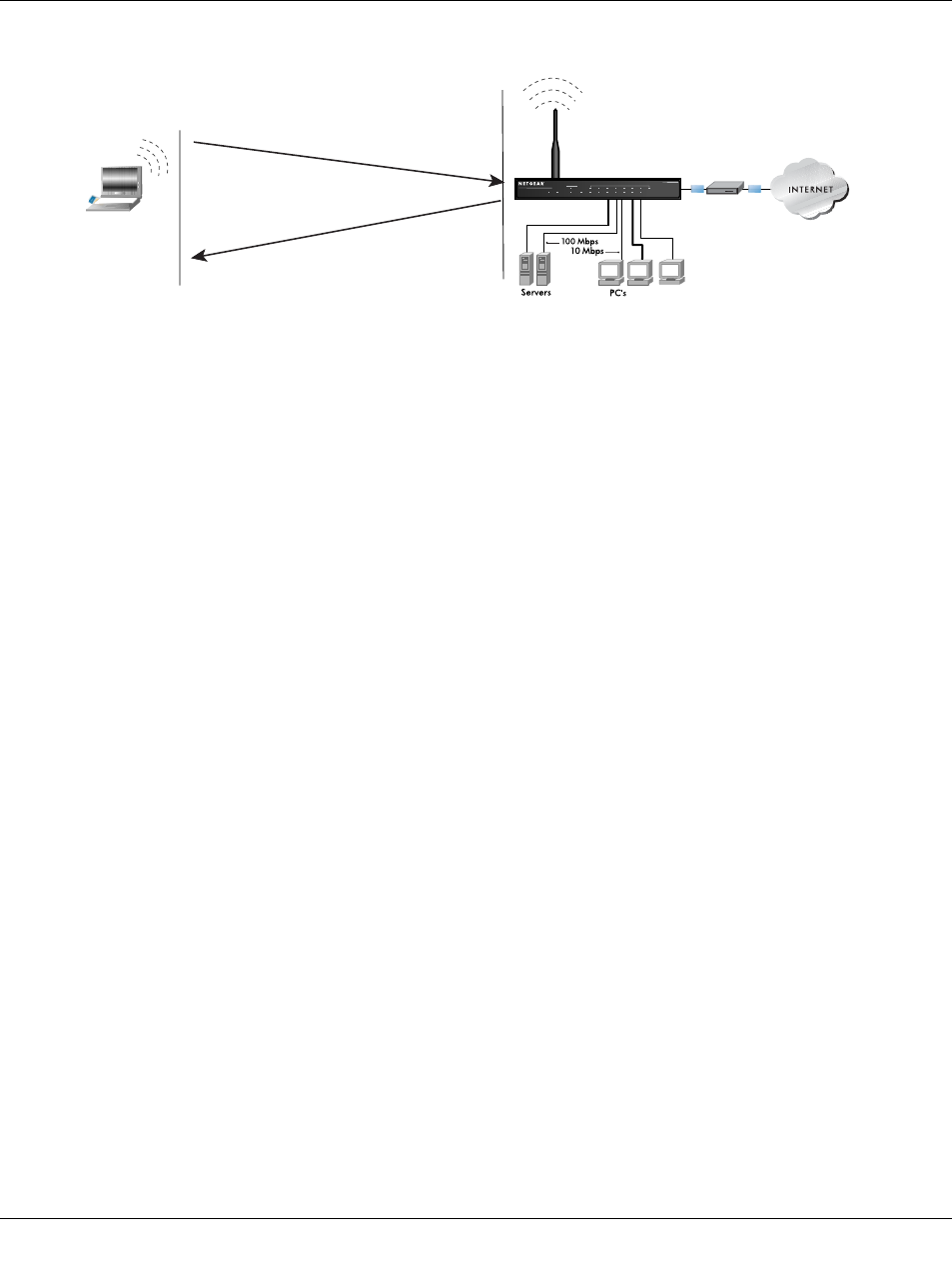
Installation Guide for the NETGEAR 108 Mbps Wireless PCI Adapter WG311T
B-4 Wireless Networking Basics
Figure 4-1: 802.11 open system authentication
Shared Key Authentication
The following steps occur when two devices use Shared Key Authentication:
1. The station sends an authentication request to the access point.
2. The access point sends challenge text to the station.
3. The station uses its configured 64-bit or 128-bit default key to encrypt the challenge text, and
sends the encrypted text to the access point.
4. The access point decrypts the encrypted text using its configured WEP Key that corresponds
to the station’s default key. The access point compares the decrypted text with the original
challenge text. If the decrypted text matches the original challenge text, then the access point
and the station share the same WEP Key and the access point authenticates the station.
5. The station connects to the network.
If the decrypted text does not match the original challenge text (i.e., the access point and station do
not share the same WEP Key), then the access point will refuse to authenticate the station and the
station will be unable to communicate with either the 802.11 network or Ethernet network.
This process is illustrated in below.
INTERNET LOCAL
ACT
12345678
LNK
LNK/ACT
100
Cable/DSL ProSafeWirelessVPN Security Firewall
MODEL FVM318
PWR TEST
WLAN
Enable
Access Point
1) Authentication request sent to AP
2) AP authenticates
3) Client connects to network
802.11b Authentication
Open System Steps
CSU/DSU
or DLS modem
Client
attempting
to connect
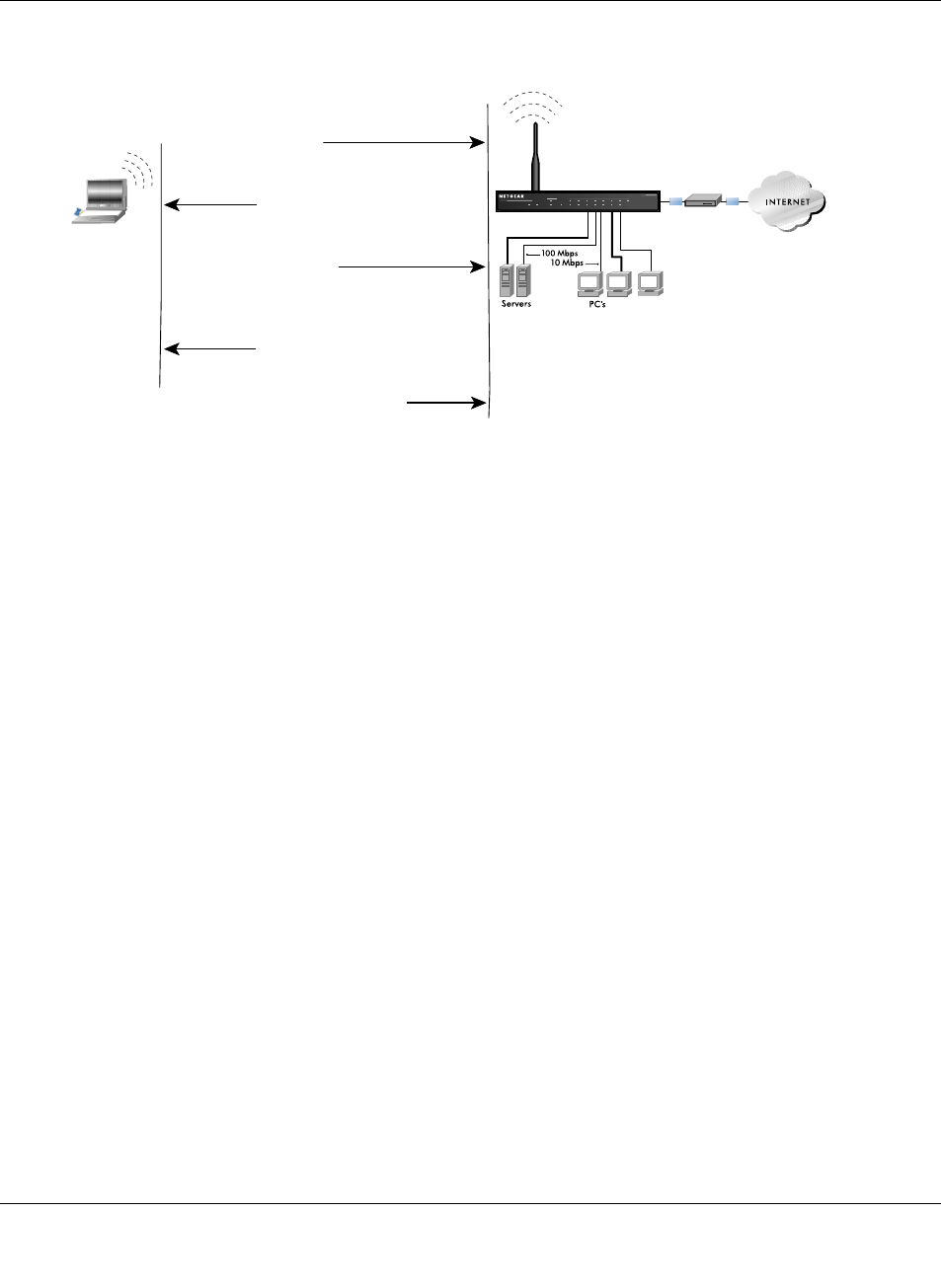
Installation Guide for the NETGEAR 108 Mbps Wireless PCI Adapter WG311T
Wireless Networking Basics B-5
Figure 4-2: 802.11 shared key authentication
Overview of WEP Parameters
Before enabling WEP on an 802.11 network, you must first consider what type of encryption you
require and the key size you want to use. Typically, there are three WEP Encryption options
available for 802.11 products:
1. Do Not Use WEP: The 802.11 network does not encrypt data. For authentication purposes, the
network uses Open System Authentication.
2. Use WEP for Encryption: A transmitting 802.11 device encrypts the data portion of every
packet it sends using a configured WEP Key. The receiving 802.11 device decrypts the data using
the same WEP Key. For authentication purposes, the 802.11 network uses Open System
Authentication.
3. Use WEP for Authentication and Encryption: A transmitting 802.11 device encrypts the data
portion of every packet it sends using a configured WEP Key. The receiving 802.11 device
decrypts the data using the same WEP Key. For authentication purposes, the 802.11 network uses
Shared Key Authentication.
Note: Some 802.11 access points also support Use WEP for Authentication Only (Shared Key
Authentication without data encryption).
INTERNET LOCAL
ACT
12345678
LNK
LNK/ACT
100
Cable/DSL ProSafeWirelessVPN Security Firewall
MODEL FVM318
PWR TEST
WLAN
Enable
Access Point (AP)1) Authentication
request sent to AP
2) AP sends challenge text
3) Client encrypts
challenge text and
sends it back to AP
4) AP decrypts, and if correct,
authenticates client
5) Client connects to network
802.11 Authentication
Shared Key Steps
Cable or
DLS modem
Client
attempting
to connect

Installation Guide for the NETGEAR 108 Mbps Wireless PCI Adapter WG311T
B-6 Wireless Networking Basics
Key Size
The IEEE 802.11 standard supports two types of WEP encryption: 40-bit and 128-bit.
The 64-bit WEP data encryption method, allows for a five-character (40-bit) input. Additionally,
24 factory-set bits are added to the forty-bit input to generate a 64-bit encryption key. (The 24
factory-set bits are not user-configurable). This encryption key will be used to encrypt/decrypt all
data transmitted via the wireless interface. Some vendors refer to the 64-bit WEP data encryption
as 40-bit WEP data encryption since the user-configurable portion of the encryption key is 40 bits
wide.
The 128-bit WEP data encryption method consists of 104 user-configurable bits. Similar to the
forty-bit WEP data encryption method, the remaining 24 bits are factory set and not user
configurable. Some vendors allow passphrases to be entered instead of the cryptic hexadecimal
characters to ease encryption key entry.
128-bit encryption is stronger than 40-bit encryption, but 128-bit encryption may not be available
outside of the United States due to U.S. export regulations.
When configured for 40-bit encryption, 802.11 products typically support up to four WEP Keys.
Each 40-bit WEP Key is expressed as 5 sets of two hexadecimal digits (0-9 and A-F). For
example, “12 34 56 78 90” is a 40-bit WEP Key.
When configured for 128-bit encryption, 802.11 products typically support four WEP Keys but
some manufacturers support only one 128-bit key. The 128-bit WEP Key is expressed as 13 sets of
two hexadecimal digits (0-9 and A-F). For example, “12 34 56 78 90 AB CD EF 12 34 56 78 90”
is a 128-bit WEP Key.
Note: Typically, 802.11 access points can store up to four 128-bit WEP Keys but some 802.11
client adapters can only store one. Therefore, make sure that your 802.11 access and client
adapters configurations match.
WEP Configuration Options
The WEP settings must match on all 802.11 devices that are within the same wireless network as
identified by the SSID. In general, if your mobile clients will roam between access points, then all
of the 802.11 access points and all of the 802.11 client adapters on the network must have the same
WEP settings.

Installation Guide for the NETGEAR 108 Mbps Wireless PCI Adapter WG311T
Wireless Networking Basics B-7
Note: Whatever keys you enter for an AP, you must also enter the same keys for the client adapter
in the same order. In other words, WEP key 1 on the AP must match WEP key 1 on the client
adapter, WEP key 2 on the AP must match WEP key 2 on the client adapter, etc.
Note: The AP and the client adapters can have different default WEP Keys as long as the keys are
in the same order. In other words, the AP can use WEP key 2 as its default key to transmit while a
client adapter can use WEP key 3 as its default key to transmit. The two devices will communicate
as long as the AP’s WEP key 2 is the same as the client’s WEP key 2 and the AP’s WEP key 3 is
the same as the client’s WEP key 3.
Wireless Channels
IEEE 802.11b and g wireless nodes communicate with each other using radio frequency signals in
the ISM (Industrial, Scientific, and Medical) band between 2.4 GHz and 2.5 GHz. Neighboring
channels are 5 MHz apart. However, due to spread spectrum effect of the signals, a node sending
signals using a particular channel will utilize frequency spectrum 12.5 MHz above and below the
center channel frequency. As a result, two separate wireless networks using neighboring channels
(for example, channel 1 and channel 2) in the same general vicinity will interfere with each other.
Applying two channels that allow the maximum channel separation will decrease the amount of
channel cross-talk, and provide a noticeable performance increase over networks with minimal
channel separation.

Installation Guide for the NETGEAR 108 Mbps Wireless PCI Adapter WG311T
B-8 Wireless Networking Basics
The radio frequency channels used are listed in Table 4-1:
Note: The available channels supported by the wireless products in various countries are different.
The preferred channel separation between the channels in neighboring wireless networks is 25
MHz (5 channels). This means that you can apply up to three different channels within your
wireless network. There are only 11 usable wireless channels in the United States. It is
recommended that you start using channel 1 and grow to use channel 6, and 11 when necessary, as
these three channels do not overlap.
WPA Wireless Security
Wi-Fi Protected Access (WPA) is a specification of standards-based, interoperable security
enhancements that increase the level of data protection and access control for existing and future
wireless LAN systems.
Table 4-1. 802.11b and g Radio Frequency Channels
Channel Center Frequency Frequency Spread
1 2412 MHz 2399.5 MHz - 2424.5 MHz
2 2417 MHz 2404.5 MHz - 2429.5 MHz
3 2422 MHz 2409.5 MHz - 2434.5 MHz
4 2427 MHz 2414.5 MHz - 2439.5 MHz
5 2432 MHz 2419.5 MHz - 2444.5 MHz
6 2437 MHz 2424.5 MHz - 2449.5 MHz
7 2442 MHz 2429.5 MHz - 2454.5 MHz
8 2447 MHz 2434.5 MHz - 2459.5 MHz
9 2452 MHz 2439.5 MHz - 2464.5 MHz
10 2457 MHz 2444.5 MHz - 2469.5 MHz
11 2462 MHz 2449.5 MHz - 2474.5 MHz
12 2467 MHz 2454.5 MHz - 2479.5 MHz
13 2472 MHz 2459.5 MHz - 2484.5 MHz

Installation Guide for the NETGEAR 108 Mbps Wireless PCI Adapter WG311T
Wireless Networking Basics B-9
The IEEE introduced the WEP as an optional security measure to secure 802.11b (Wi-Fi) WLANs,
but inherent weaknesses in the standard soon became obvious. In response to this situation, the
Wi-Fi Alliance announced a new security architecture in October 2002 that remedies the
shortcomings of WEP. This standard, formerly known as Safe Secure Network (SSN), is designed
to work with existing 802.11 products and offers forward compatibility with 802.11i, the new
wireless security architecture being defined in the IEEE.
WPA offers the following benefits:
• Enhanced data privacy
• Robust key management
• Data origin authentication
• Data integrity protection
The Wi-Fi Alliance is now performing interoperability certification testing on Wi-Fi Protected
Access products. Starting August of 2003, all new Wi-Fi certified products will have to support
WPA. NETGEAR will implement WPA on client and access point products and make this
available in the second half of 2003. Existing Wi-Fi certified products will have one year to add
WPA support or they will lose their Wi-Fi certification.
The 802.11i standard is currently in draft form, with ratification due at the end of 2003. While the
new IEEE 802.11i standard is being ratified, wireless vendors have agreed on WPA as an
interoperable interim standard.
How Does WPA Compare to WEP?
WEP is a data encryption method and is not intended as a user authentication mechanism. WPA
user authentication is implemented using 802.1x and the Extensible Authentication Protocol
(EAP). Support for 802.1x authentication is required in WPA. In the 802.11 standard, 802.1x
authentication was optional. For details on EAP specifically, refer to IETF's RFC 2284.
With 802.11 WEP, all access points and client wireless adapters on a particular wireless LAN must
use the same encryption key. A major problem with the 802.11 standard is that the keys are
cumbersome to change. If you do not update the WEP keys often, an unauthorized person with a
sniffing tool can monitor your network for less than a day and decode the encrypted messages.
Products based on the 802.11 standard alone offer system administrators no effective method to
update the keys.

Installation Guide for the NETGEAR 108 Mbps Wireless PCI Adapter WG311T
B-10 Wireless Networking Basics
For 802.11, WEP encryption is optional. For WPA, encryption using Temporal Key Integrity
Protocol (TKIP) is required. TKIP replaces WEP with a new encryption algorithm that is stronger
than the WEP algorithm, but that uses the calculation facilities present on existing wireless devices
to perform encryption operations. TKIP provides important data encryption enhancements
including a per-packet key mixing function, a message integrity check (MIC) named Michael, an
extended initialization vector (IV) with sequencing rules, and a re-keying mechanism. Through
these enhancements, TKIP addresses all of the known WEP vulnerabilities.
How Does WPA Compare to IEEE 802.11i?
WPA will be forward compatible with the IEEE 802.11i security specification currently under
development. WPA is a subset of the current 802.11i draft and uses certain pieces of the 802.11i
draft that are ready to bring to market today, such as 802.1x and TKIP. The main pieces of the
802.11i draft that are not included in WPA are secure IBSS (Ad Hoc mode), secure fast handoff
(for specialized 802.11 VoIP phones), as well as enhanced encryption protocols, such as
AES-CCMP. These features are either not yet ready for market or will require hardware upgrades
to implement.
What are the Key Features of WPA Security?
The following security features are included in the WPA standard:
• WPA Authentication
• WPA Encryption Key Management
– Temporal Key Integrity Protocol (TKIP)
– Michael message integrity code (MIC)
– AES Support (to be phased in)
• Support for a Mixture of WPA and WEP Wireless Clients, but mixing WEP and WPA is
discouraged
These features are discussed below.
WPA addresses most of the known WEP vulnerabilities and is primarily intended for wireless
infrastructure networks as found in the enterprise. This infrastructure includes stations, access
points, and authentication servers (typically RADIUS servers). The RADIUS server holds (or has
access to) user credentials (for example, user names and passwords) and authenticates wireless
users before they gain access to the network.

Installation Guide for the NETGEAR 108 Mbps Wireless PCI Adapter WG311T
Wireless Networking Basics B-11
The strength of WPA comes from an integrated sequence of operations that encompass 802.1X/
EAP authentication and sophisticated key management and encryption techniques. Its major
operations include:
• Network security capability determination. This occurs at the 802.11 level and is
communicated through WPA information elements in Beacon, Probe Response, and (Re)
Association Requests. Information in these elements includes the authentication method
(802.1X or Pre-shared key) and the preferred cipher suite (WEP, TKIP, or AES).
The primary information conveyed in the Beacon frames is the authentication method and the
cipher suite. Possible authentication methods include 802.1X and Pre-shared key. Pre-shared
key is an authentication method that uses a statically configured pass phrase on both the
stations and the access point. This obviates the need for an authentication server, which in
many home and small office environments will not be available nor desirable. Possible cipher
suites include: WEP, TKIP, and AES (Advanced Encryption Standard). We talk more about
TKIP and AES when addressing data privacy below.
• Authentication. EAP over 802.1X is used for authentication. Mutual authentication is gained
by choosing an EAP type supporting this feature and is required by WPA. 802.1X port access
control prevents full access to the network until authentication completes. 802.1X
EAPOL-Key packets are used by WPA to distribute per-session keys to those stations
successfully authenticated.
The supplicant in the station uses the authentication and cipher suite information contained in
the information elements to decide which authentication method and cipher suite to use. For
example, if the access point is using the pre-shared key method then the supplicant need not
authenticate using full-blown 802.1X. Rather, the supplicant must simply prove to the access
point that it is in possession of the pre-shared key. If the supplicant detects that the service set
does not contain a WPA information element then it knows it must use pre-WPA 802.1X
authentication and key management in order to access the network.
• Key management. WPA features a robust key generation/management system that integrates
the authentication and data privacy functions. Keys are generated after successful
authentication and through a subsequent 4-way handshake between the station and Access
Point (AP).
• Data Privacy (Encryption). Temporal Key Integrity Protocol (TKIP) is used to wrap WEP in
sophisticated cryptographic and security techniques to overcome most of its weaknesses.
• Data integrity. TKIP includes a message integrity code (MIC) at the end of each plaintext
message to ensure messages are not being spoofed.
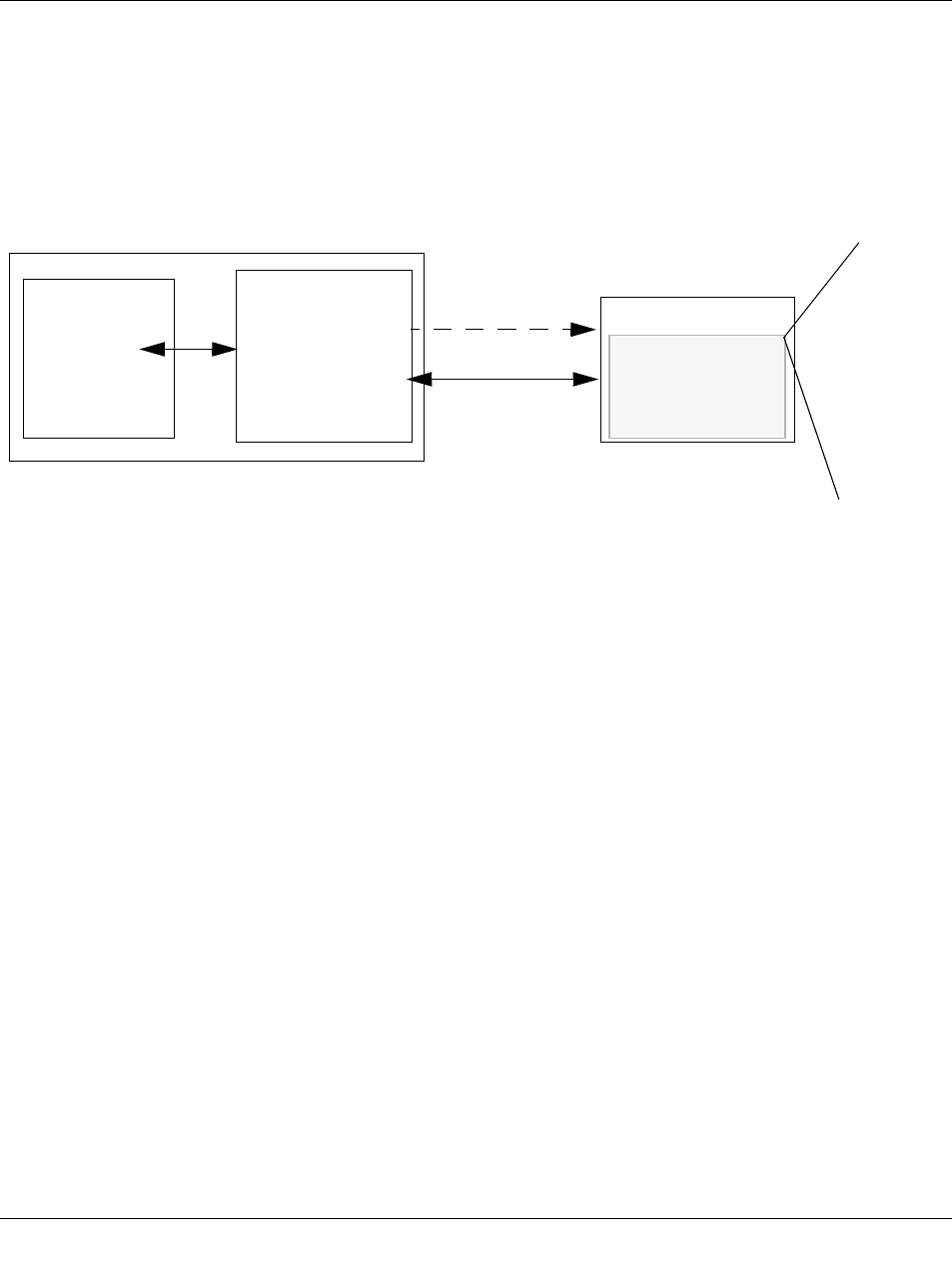
Installation Guide for the NETGEAR 108 Mbps Wireless PCI Adapter WG311T
B-12 Wireless Networking Basics
WPA Authentication: Enterprise-level User
Authentication via 802.1x/EAP and RADIUS
Figure B-1: WPA Overview
IEEE 802.1x offers an effective framework for authenticating and controlling user traffic to a
protected network, as well as providing a vehicle for dynamically varying data encryption keys via
EAP from a RADIUS server, for example. This framework enables using a central authentication
server, which employs mutual authentication so that a rogue wireless user does not join the
network.
It is important to note that 802.1x does not provide the actual authentication mechanisms. When
using 802.1x, the EAP type, such as Transport Layer Security (EAP-TLS), or EAP Tunneled
Transport Layer Security (EAP-TTLS), defines how the authentication takes place.
Note: For environments with a Remote Authentication Dial-In User Service (RADIUS)
infrastructure, WPA supports Extensible Authentication Protocol (EAP). For environments
without a RADIUS infrastructure, WPA supports the use of a pre-shared key.
Together, these technologies provide a framework for strong user authentication.
Windows XP implements 802.1x natively, and several NETGEAR switch and wireless access
point products support 802.1x.
Certificate
Authority
(for
example
Win Server,
VeriSign)
WPA
enabled
wireless
client with
“supplicant”
TCP/IP
Ports Closed
Until RADIUS Server
Wired Network with Optional
802.1x Port Based Network
Access Control
WPA enabled
Access Point
using
pre-shared key
or
802.1x
TCP/IP
Ports Opened
After
Authenticated
Wireless LAN
Login
Authentication
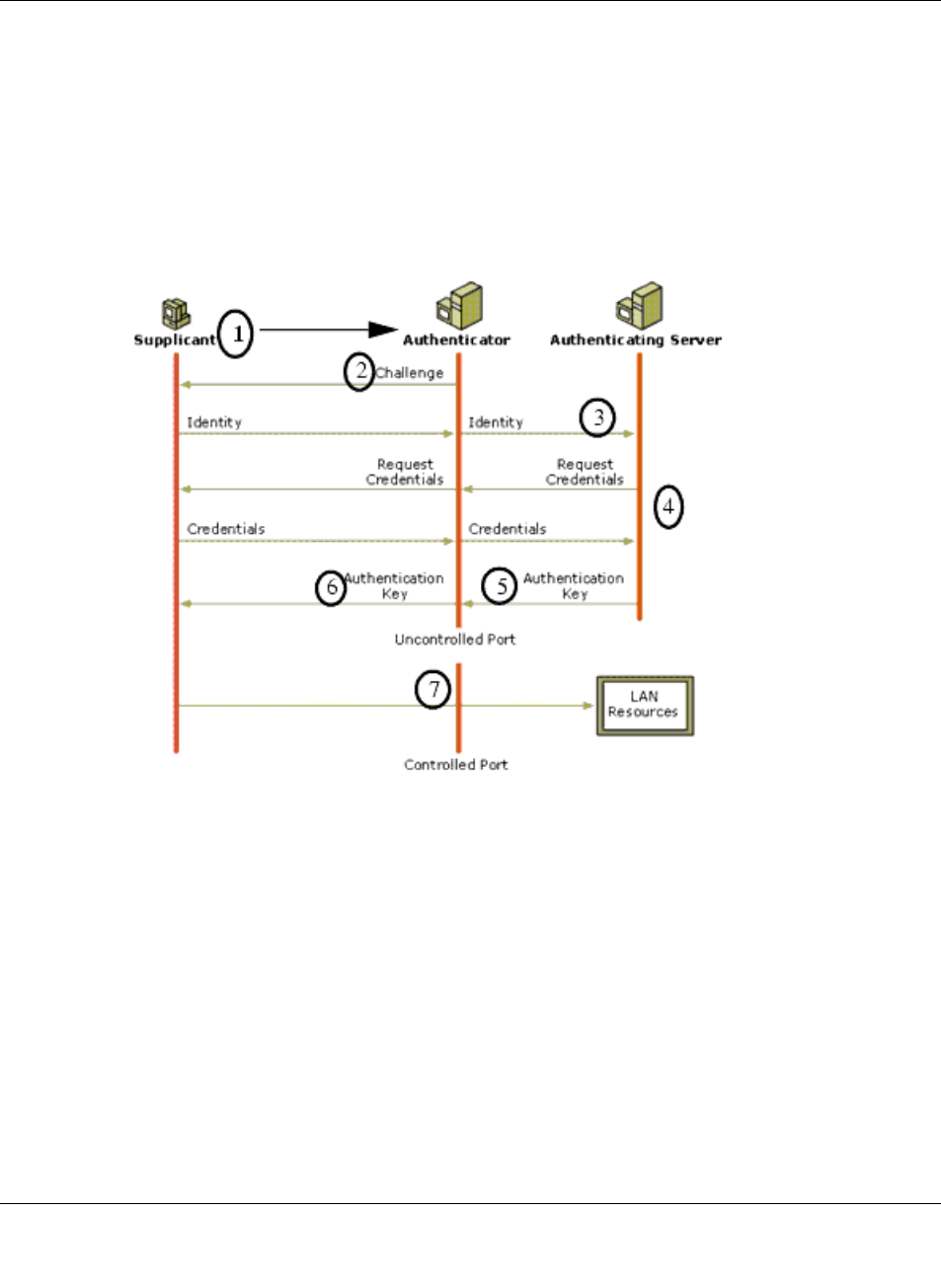
Installation Guide for the NETGEAR 108 Mbps Wireless PCI Adapter WG311T
Wireless Networking Basics B-13
Figure B-2: 802.1x Authentication Sequence
The AP sends Beacon Frames with WPA information element to the stations in the service set.
Information elements include the required authentication method (802.1x or Pre-shared key) and
the preferred cipher suite (WEP, TKIP, or AES). Probe Responses (AP to station) and Association
Requests (station to AP) also contain WPA information elements.
1. Initial 802.1x communications begin with an unauthenticated supplicant (client device)
attempting to connect with an authenticator (802.11 access point). The client sends an
EAP-start message. This begins a series of message exchanges to authenticate the client.
2. The access point replies with an EAP-request identity message.
Client with a WPA-
enabled wireless
adapter and supplicant
(Win XP, Funk,
Meetinghouse)
For example, a
WPA-enabled AP
For example, a
RADIUS server

Installation Guide for the NETGEAR 108 Mbps Wireless PCI Adapter WG311T
B-14 Wireless Networking Basics
3. The client sends an EAP-response packet containing the identity to the authentication server.
The access point responds by enabling a port for passing only EAP packets from the client to
an authentication server located on the wired side of the access point. The access point blocks
all other traffic, such as HTTP, DHCP, and POP3 packets, until the access point can verify the
client's identity using an authentication server (for example, RADIUS).
4. The authentication server uses a specific authentication algorithm to verify the client's identity.
This could be through the use of digital certificates or some other EAP authentication type.
5. The authentication server will either send an accept or reject message to the access point.
6. The access point sends an EAP-success packet (or reject packet) to the client.
7. If the authentication server accepts the client, then the access point will transition the client's
port to an authorized state and forward additional traffic.
The important part to know at this point is that the software supporting the specific EAP type
resides on the authentication server and within the operating system or application “supplicant”
software on the client devices. The access point acts as a “pass through” for 802.1x messages,
which means that you can specify any EAP type without needing to upgrade an 802.1x-compliant
access point. As a result, you can update the EAP authentication type to such devices as token
cards (Smart Cards), Kerberos, one-time passwords, certificates, and public key authentication, or
as newer types become available and your requirements for security change.
WPA Data Encryption Key Management
With 802.1x, the rekeying of unicast encryption keys is optional. Additionally, 802.11 and 802.1x
provide no mechanism to change the global encryption key used for multicast and broadcast
traffic. With WPA, rekeying of both unicast and global encryption keys is required.
For the unicast encryption key, the Temporal Key Integrity Protocol (TKIP) changes the key for
every frame, and the change is synchronized between the wireless client and the wireless access
point (AP). For the global encryption key, WPA includes a facility (the Information Element) for
the wireless AP to advertise the changed key to the connected wireless clients.
If configured to implement dynamic key exchange, the 802.1x authentication server can return
session keys to the access point along with the accept message. The access point uses the session
keys to build, sign and encrypt an EAP key message that is sent to the client immediately after
sending the success message. The client can then use contents of the key message to define
applicable encryption keys. In typical 802.1x implementations, the client can automatically change
encryption keys as often as necessary to minimize the possibility of eavesdroppers having enough
time to crack the key in current use.

Installation Guide for the NETGEAR 108 Mbps Wireless PCI Adapter WG311T
Wireless Networking Basics B-15
Temporal Key Integrity Protocol (TKIP)
WPA uses TKIP to provide important data encryption enhancements including a per-packet key
mixing function, a message integrity check (MIC) named Michael, an extended initialization
vector (IV) with sequencing rules, and a re-keying mechanism. TKIP also provides for the
following:
• The verification of the security configuration after the encryption keys are determined.
• The synchronized changing of the unicast encryption key for each frame.
• The determination of a unique starting unicast encryption key for each preshared key
authentication.
Michael
With 802.11 and WEP, data integrity is provided by a 32-bit integrity check value (ICV) that is
appended to the 802.11 payload and encrypted with WEP. Although the ICV is encrypted, you can
use cryptanalysis to change bits in the encrypted payload and update the encrypted ICV without
being detected by the receiver.
With WPA, a method known as Michael specifies a new algorithm that calculates an 8-byte
message integrity check (MIC) using the calculation facilities available on existing wireless
devices. The MIC is placed between the data portion of the IEEE 802.11 frame and the 4-byte ICV.
The MIC field is encrypted together with the frame data and the ICV.
Michael also provides replay protection. A new frame counter in the IEEE 802.11 frame is used to
prevent replay attacks.
Optional AES Support to be Phased In
One of the encryption methods supported by WPA, besides TKIP, is the advanced encryption
standard (AES), although AES support will not be required initially for Wi-Fi certification. This is
viewed as the optimal choice for security conscience organizations, but the problem with AES is
that it requires a fundamental redesign of the NIC’s hardware in both the station and the access
point. TKIP is a pragmatic compromise that allows organizations to deploy better security while
AES capable equipment is being designed, manufactured, and incrementally deployed.

Installation Guide for the NETGEAR 108 Mbps Wireless PCI Adapter WG311T
B-16 Wireless Networking Basics
Is WPA Perfect?
WPA is not without its vulnerabilities. Specifically, it is susceptible to denial of service (DoS)
attacks. If the access point receives two data packets that fail the message integrity code (MIC)
within 60 seconds of each other, then the network is under an active attack, and as a result, the
access point employs counter measures, which include disassociating each station using the access
point. This prevents an attacker from gleaning information about the encryption key and alerts
administrators, but it also causes users to lose network connectivity for 60 seconds. More than
anything else, this may just prove that no single security tactic is completely invulnerable. WPA is
a definite step forward in WLAN security over WEP and has to be thought of as a single part of an
end-to-end network security strategy.
Product Support for WPA
Starting in August, 2003, NETGEAR, Inc. wireless Wi-Fi certified products will support the WPA
standard. NETGEAR, Inc. wireless products that had their Wi-Fi certification approved before
August, 2003 will have one year to add WPA so as to maintain their Wi-Fi certification.
WPA requires software changes to the following:
• Wireless access points
• Wireless network adapters
• Wireless client programs
Supporting a Mixture of WPA and WEP Wireless Clients is Discouraged
To support the gradual transition of WEP-based wireless networks to WPA, a wireless AP can
support both WEP and WPA clients at the same time. During the association, the wireless AP
determines which clients use WEP and which clients use WPA. The disadvantage to supporting a
mixture of WEP and WPA clients is that the global encryption key is not dynamic. This is because
WEP-based clients cannot support it. All other benefits to the WPA clients, such as integrity, are
maintained.
However, a mixed mode supporting WPA and non-WPA clients would offer network security that
is no better than that obtained with a non-WPA network, and thus this mode of operation is
discouraged.

Installation Guide for the NETGEAR 108 Mbps Wireless PCI Adapter WG311T
Wireless Networking Basics B-17
Changes to Wireless Access Points
Wireless access points must have their firmware updated to support the following:
•The new WPA information element
To advertise their support of WPA, wireless APs send the beacon frame with a new 802.11
WPA information element that contains the wireless AP's security configuration (encryption
algorithms and wireless security configuration information).
•The WPA two-phase authentication
Open system, then 802.1x (EAP with RADIUS or preshared key).
•TKIP
•Michael
•AES (optional)
To upgrade your wireless access points to support WPA, obtain a WPA firmware update from your
wireless AP vendor and upload it to your wireless AP.
Changes to Wireless Network Adapters
Wireless networking software in the adapter, and possibly in the OS or client application, must be
updated to support the following:
•The new WPA information element
Wireless clients must be able to process the WPA information element and respond with a
specific security configuration.
•The WPA two-phase authentication
Open system, then 802.1x supplicant (EAP or preshared key).
•TKIP
•Michael
•AES (optional)
To upgrade your wireless network adapters to support WPA, obtain a WPA update from your
wireless network adapter vendor and update the wireless network adapter driver.
For Windows wireless clients, you must obtain an updated network adapter driver that supports
WPA. For wireless network adapter drivers that are compatible with Windows XP (Service Pack 1)
and Windows Server 2003, the updated network adapter driver must be able to pass the adapter's
WPA capabilities and security configuration to the Wireless Zero Configuration service.

Installation Guide for the NETGEAR 108 Mbps Wireless PCI Adapter WG311T
B-18 Wireless Networking Basics
Microsoft has worked with many wireless vendors to embed the WPA firmware update in the
wireless adapter driver. So, to update your Microsoft Windows wireless client, all you have to do is
obtain the new WPA-compatible driver and install the driver. The firmware is automatically
updated when the wireless network adapter driver is loaded in Windows.
Changes to Wireless Client Programs
Wireless client programs must be updated to permit the configuration of WPA authentication (and
preshared key) and the new WPA encryption algorithms (TKIP and the optional AES component).
To obtain the Microsoft WPA client program, visit the Microsoft Web site.

Preparing Your PCs for Network Access C-1
Appendix C
Preparing Your PCs for Network Access
This appendix describes how to prepare your PCs to connect to the Internet through the
NETGEAR 108 Mbps Wireless PCI Adapter WG311T.
For adding file and print sharing to your network, please consult the Windows help information
included with the version of Windows installed on each computer on your network.
Preparing Your Computers for TCP/IP Networking
Computers access the Internet using a protocol called TCP/IP (Transmission Control Protocol/
Internet Protocol). Each computer on your network must have TCP/IP installed and selected as its
networking protocol. If a Network Interface Card (NIC) is already installed in your PC, then TCP/
IP is probably already installed as well.
Most operating systems include the software components you need for networking with TCP/IP.
Windows 95 or later includes the software components for establishing a TCP/IP network.
In your TCP/IP network, each PC and the wireless access point must be assigned a unique IP
addresses. Each PC must also have certain other TCP/IP configuration information such as a
subnet mask (netmask), a domain name server (DNS) address, and a default gateway address. In
most cases, you should install TCP/IP so that the PC obtains its specific network configuration
information automatically from a DHCP server during startup.
Configuring Windows 98SE and Me for TCP/IP Networking
As part of the PC preparation process, you may need to install and configure
TCP/IP on your PC. Before starting, locate your Windows CD; you may need to insert it during the
TCP/IP installation process.
Install or Verify Windows Networking Components
To install or verify the necessary components for IP networking:
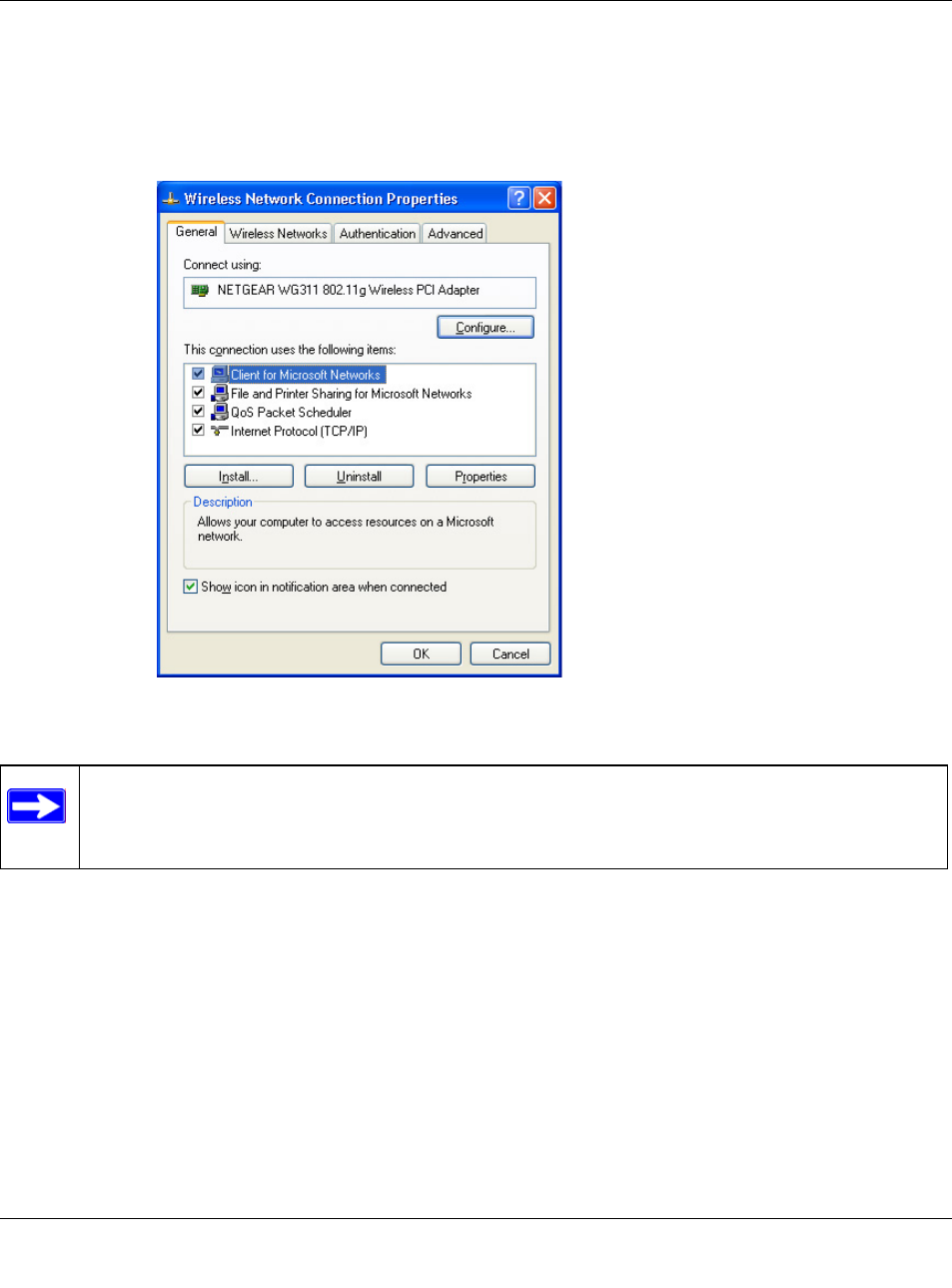
Installation Guide for the NETGEAR 108 Mbps Wireless PCI Adapter WG311T
C-2 Preparing Your PCs for Network Access
1. On the Windows taskbar, click the Start button, point to Settings, and then click Control Panel.
2. Double-click the Network icon.
The Network window opens, which displays a list of installed components:
You must have an Ethernet adapter or an WG311T, the TCP/IP protocol, and the Client for
Microsoft Networks.
If you need to add TCP/IP:
a. Click the Add button.
b. Select Protocol, and then click Add.
c. Select Microsoft.
d. Select TCP/IP, and then click OK.
If you need to add the Client for Microsoft Networks:
a. Click the Add button.
b. Select Client, and then click Add.
c. Select Microsoft.
Note: It is not necessary to remove any other network components shown in the
Network window in order to install the adapter, TCP/IP, or Client for Microsoft
Networks.

Installation Guide for the NETGEAR 108 Mbps Wireless PCI Adapter WG311T
Preparing Your PCs for Network Access C-3
d. Select Client for Microsoft Networks, and then click OK.
If you need to add File and Print Sharing for Microsoft Networks:
a. Click the Add button.
b. Select Client, and then click Add.
c. Select Microsoft.
d. Select File and Print Sharing for Microsoft Networks, and then click OK.
3. Restart your PC for the changes to take effect.
Enabling DHCP to Automatically Configure TCP/IP Settings in
Windows 98SE and Me
After the TCP/IP protocol components are installed, each PC must be assigned specific
information about itself and resources that are available on its network. The simplest way to
configure this information is to allow the PC to obtain the information from a DHCP server in the
network.
You will find there are many similarities in the procedures for different Windows systems
when using DHCP to configure TCP/IP.
The following steps will walk you through the configuration process for each of these
versions of Windows.
Locate your Network Neighborhood icon.
• If the Network Neighborhood icon is on the Windows desktop, position your
mouse pointer over it and right-click your mouse button.
• If the icon is not on the desktop,
• Click Start on the task bar located at the bottom left of the window.
• Choose Settings, and then Control Panel.
• Locate the Network Neighborhood icon and click on it. This will open
the Network panel as shown below.
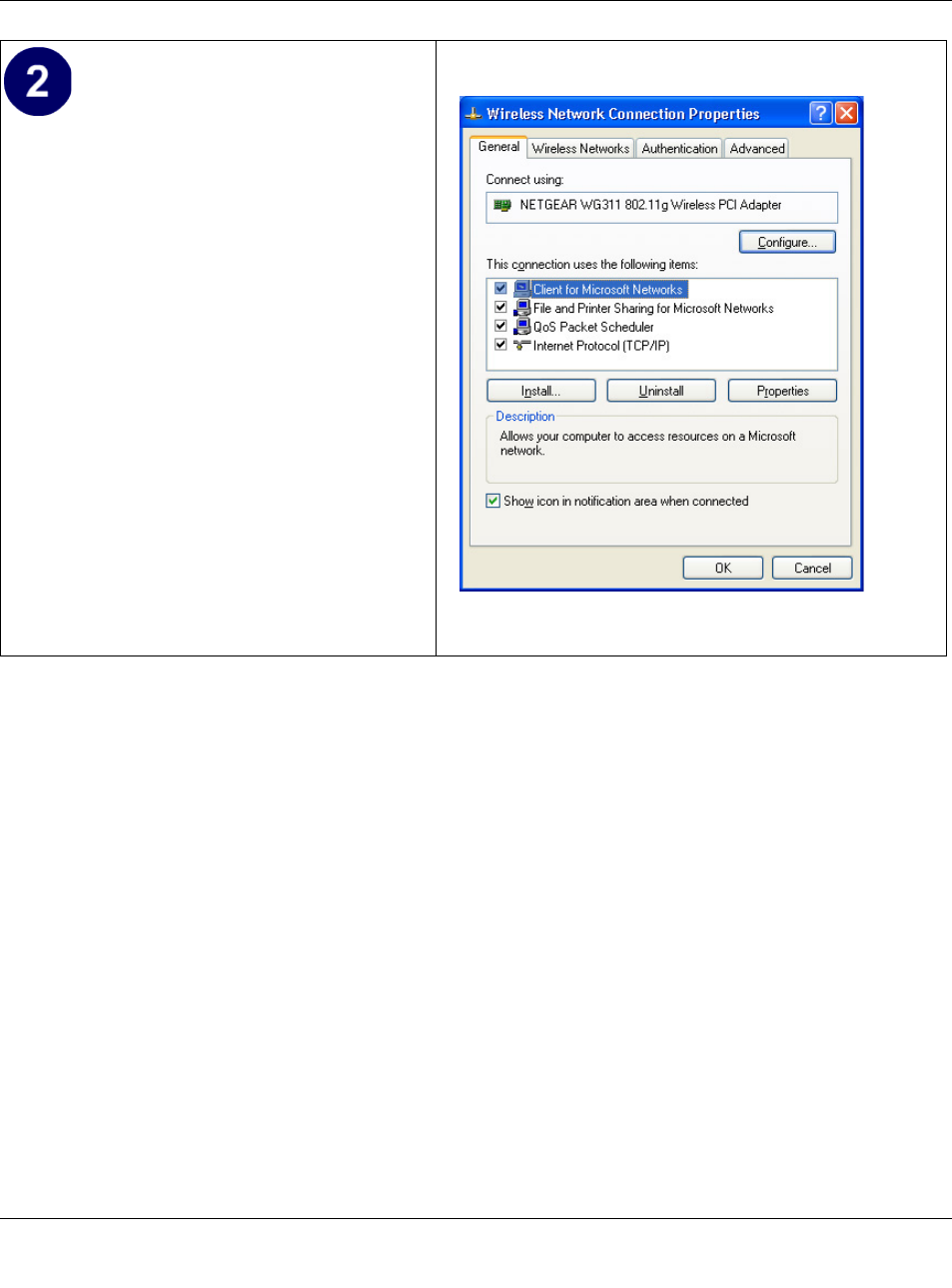
Installation Guide for the NETGEAR 108 Mbps Wireless PCI Adapter WG311T
C-4 Preparing Your PCs for Network Access
Verify the following settings as shown:
• Client for Microsoft Network exists
• Ethernet adapter is present
• TCP/IP is present
•Primary Network Logon is set to
Windows logon
Click on the Properties button. The
following TCP/IP Properties window will
display.
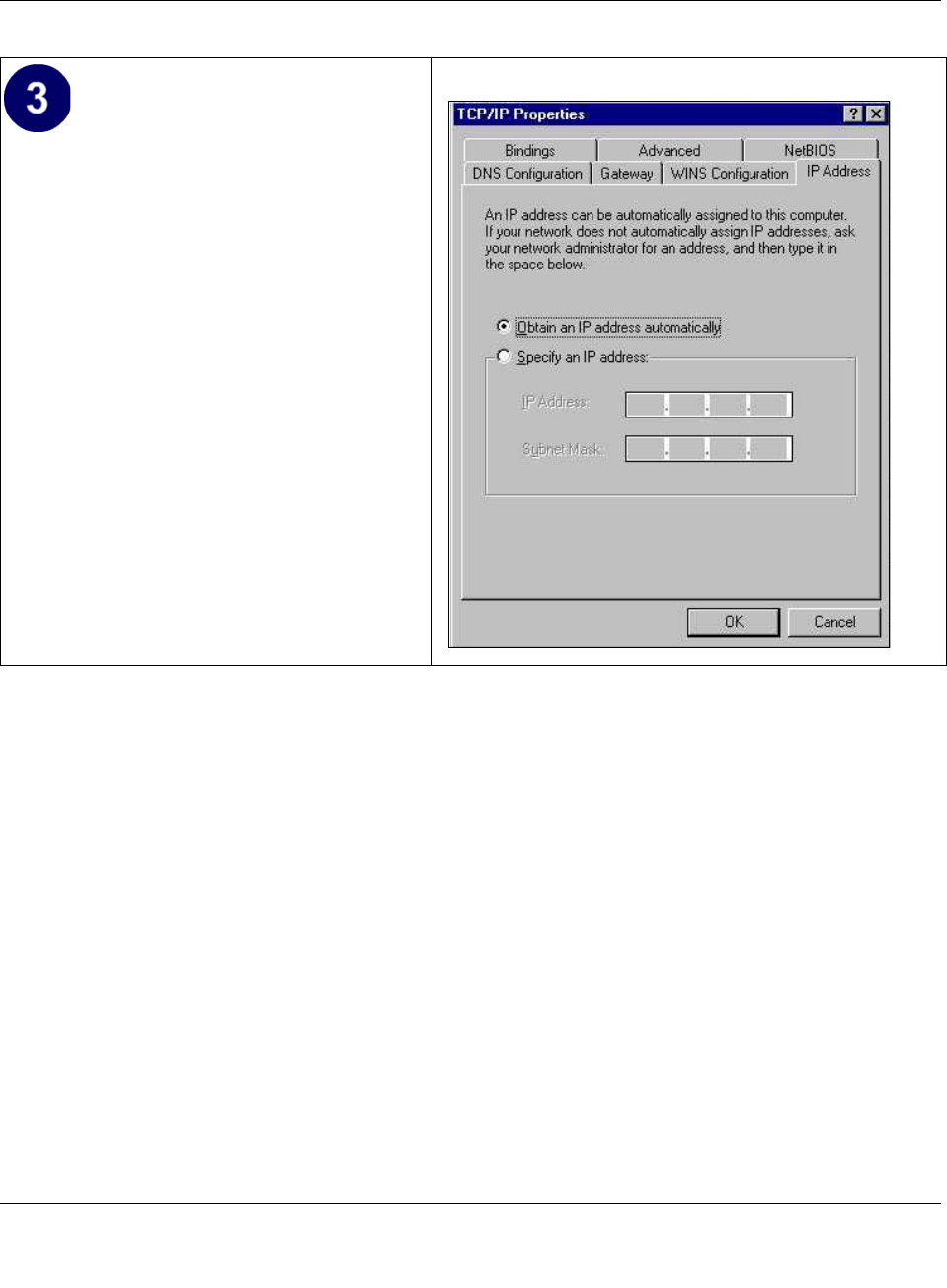
Installation Guide for the NETGEAR 108 Mbps Wireless PCI Adapter WG311T
Preparing Your PCs for Network Access C-5
Selecting the Internet Access Method
1. On the Windows taskbar, click the Start button, point to Settings, and then click Control Panel.
2. Double-click the Internet Options icon.
3. Select “I want to set up my Internet connection manually” or “I want to connect through a
Local Area Network” and click Next.
4. Select “I want to connect through a Local Area Network” and click Next.
5. Uncheck all boxes in the LAN Internet Configuration screen and click Next.
6. Proceed to the end of the Wizard.
Verifying TCP/IP Properties
After your PC is configured and has rebooted, you can check the TCP/IP configuration using the
utility winipcfg.exe:
1. On the Windows taskbar, click the Start button, and then click Run.
By default, the IP Address tab is open on
this window.
• Verify the following:
Obtain an IP address automatically is
selected. If not selected, click in the
radio button to the left of it to select it.
This setting is required to enable the
DHCP server to automatically assign an
IP address.
• Click OK to continue.
Restart the PC.
Repeat these steps for each PC with this
version of Windows on your network.

Installation Guide for the NETGEAR 108 Mbps Wireless PCI Adapter WG311T
C-6 Preparing Your PCs for Network Access
2. Type winipcfg, and then click OK.
The IP Configuration window opens, which lists (among other things), your IP address, subnet
mask, and default gateway.
3. From the drop-down box, select your Ethernet adapter.
The window is updated to show your settings, which should match the values below if you are
using the default TCP/IP settings that NETGEAR recommends for connecting through a
router or gateway:
• The IP address is between 192.168.0.2 and 192.168.0.254
• The subnet mask is 255.255.255.0
• The default gateway is 192.168.0.1
Configuring Windows 2000 or XP for TCP/IP Networking
As part of the PC preparation process, you may need to install and configure
TCP/IP on each networked PC. Before starting, locate your Windows CD; you may need to insert
it during the TCP/IP installation process.
Install or Verify Windows Networking Components
To install or verify the necessary components for IP networking:
1. On the Windows taskbar, click the Start button, point to Settings, and then click Control Panel.
2. Double-click the Network and Dial-up Connections icon.
3. If an Ethernet adapter is present in your PC, you should see an entry for Local Area
Connection. Double-click that entry.
4. Select Properties.
5. Verify that ‘Client for Microsoft Networks’ and ‘Internet Protocol (TCP/IP)’ are present. If
not, select Install and add them.
6. Select ‘Internet Protocol (TCP/IP)’, click Properties, and verify that “Obtain an IP address
automatically is selected.
7. Click OK and close all Network and Dial-up Connections windows.
8. Then, restart your PC.
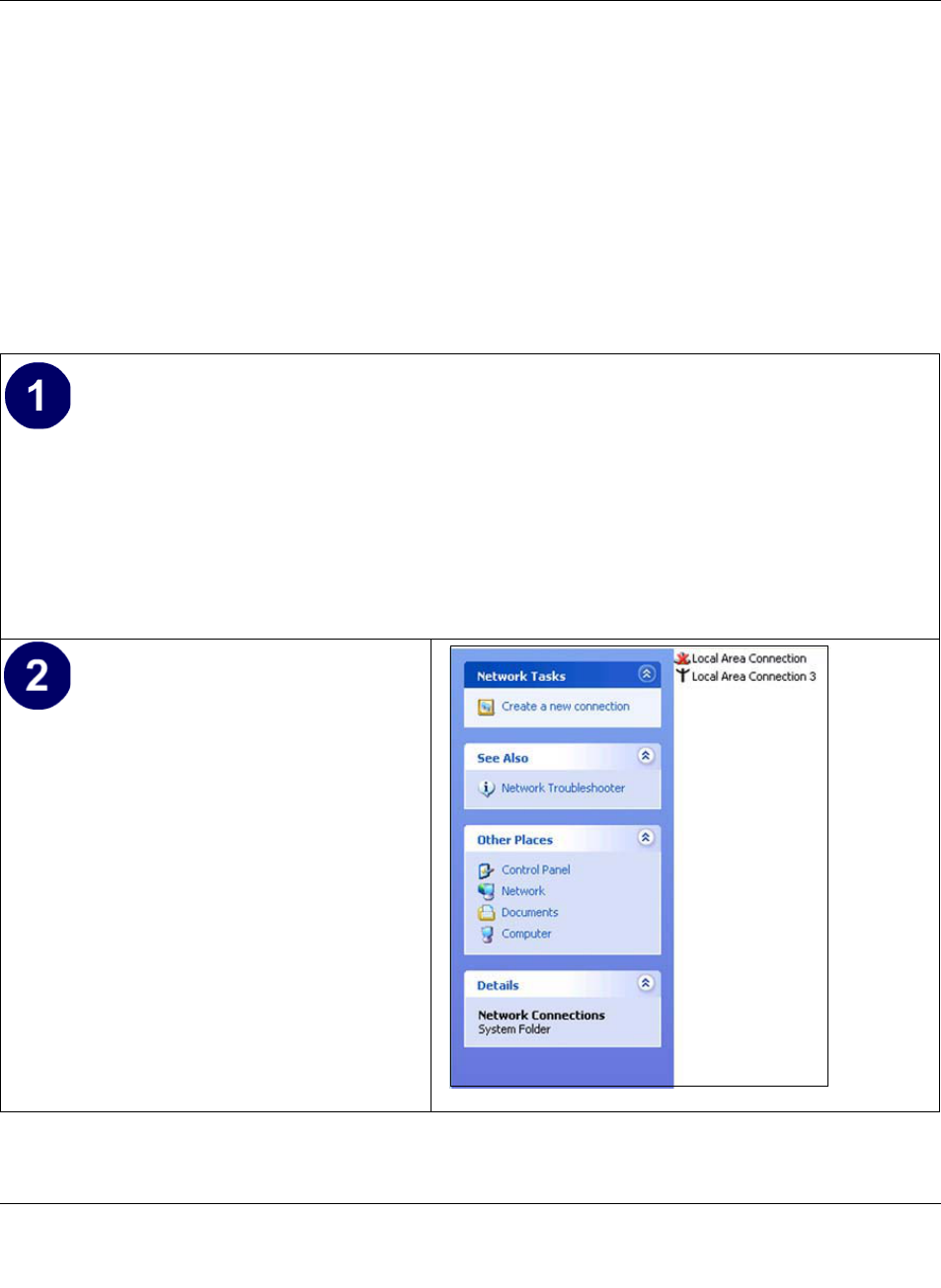
Installation Guide for the NETGEAR 108 Mbps Wireless PCI Adapter WG311T
Preparing Your PCs for Network Access C-7
DHCP Configuration of TCP/IP in Windows XP or 2000
You will find there are many similarities in the procedures for different Windows systems when
using DHCP to configure TCP/IP.
The following steps will walk you through the configuration process for each of these versions of
Windows.
DHCP Configuration of TCP/IP in Windows XP
Locate your Network Neighborhood icon.
• Select Control Panel from the Windows XP Start Menu.
• Select the Network Connections icon on the Control Panel. This will take you to the next
step.
Now the Network Connection window
displays.
The Connections List that shows all the
network connections set up on the PC,
located to the right of the window.
• Right-click on the Connection with the
wireless icon and choose Status.
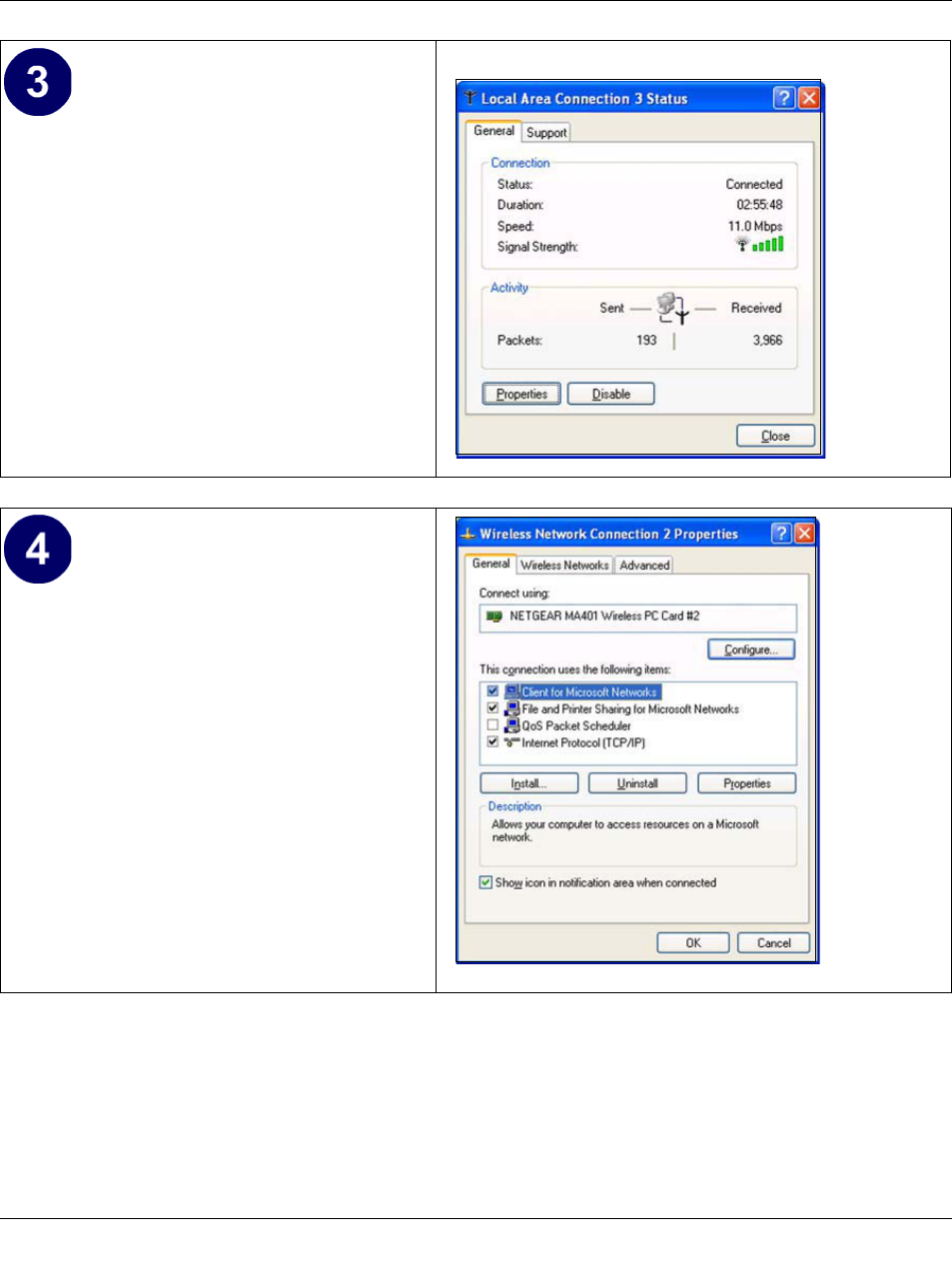
Installation Guide for the NETGEAR 108 Mbps Wireless PCI Adapter WG311T
C-8 Preparing Your PCs for Network Access
Now you should be at the Local Area
Network Connection Status window. This
box displays the connection status,
duration, speed, and activity statistics.
Administrator logon access rights are
needed to use this window.
• Click the Properties button to view
details about the connection.
The TCP/IP details are presented on the
Support tab page.
• Select Internet Protocol, and click
Properties to view the configuration
information.
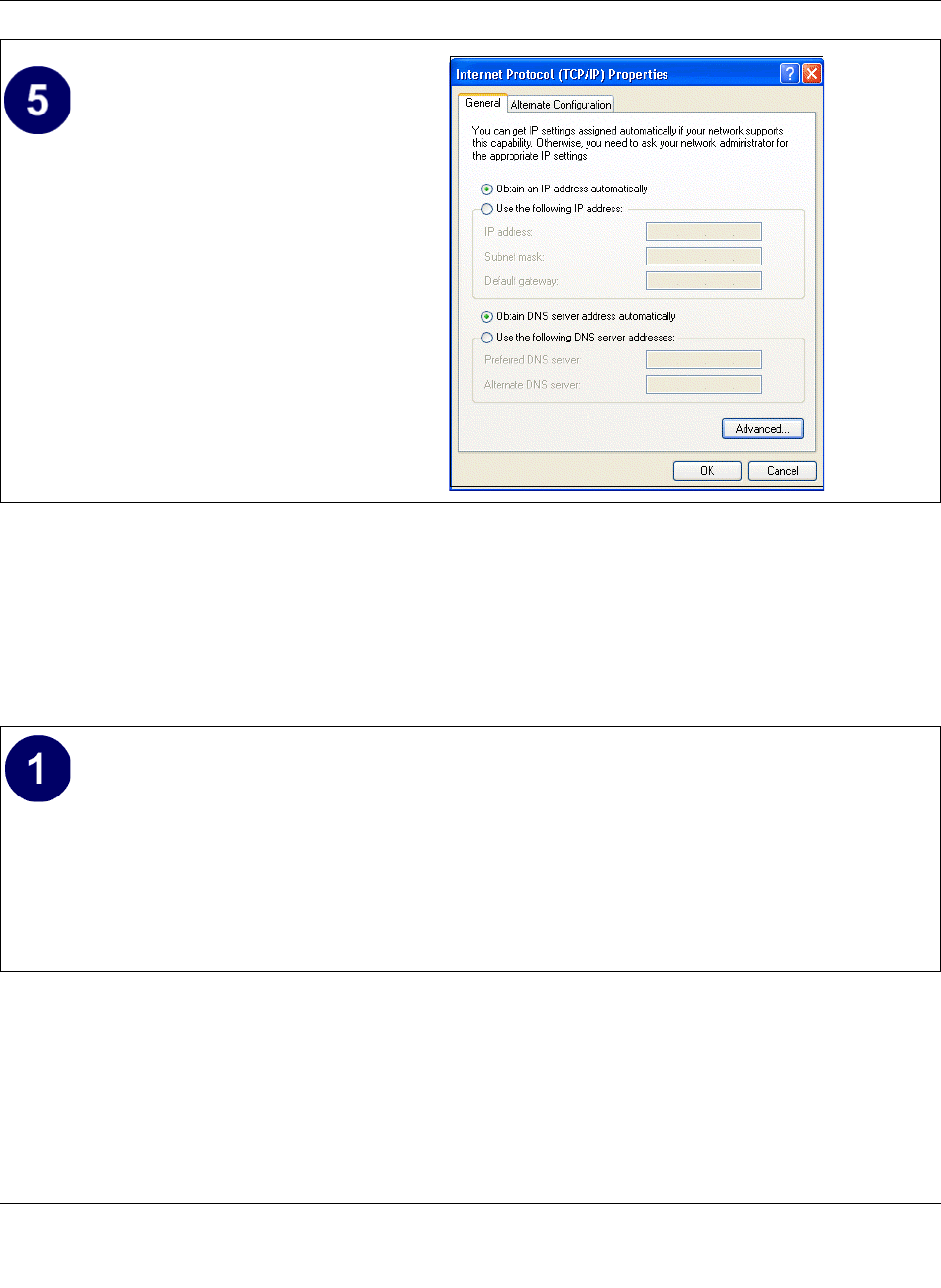
Installation Guide for the NETGEAR 108 Mbps Wireless PCI Adapter WG311T
Preparing Your PCs for Network Access C-9
DHCP Configuration of TCP/IP in Windows 2000
After you install a network card, TCP/IP for Windows 2000 is configured and set to DHCP
without your having to configure it. However, if there are problems, following the steps below to
configure TCP/IP with DHCP for Windows 2000.
Verify that Obtain an IP address
automatically radio button is selected and
that the Obtain DNS server address
automatically radio button is selected.
• Click the OK button.
This completes the DHCP configuration in
Windows XP.
Repeat these steps for each PC with this
version of Windows on your network.
Click on the My Network Places icon on the Windows desktop. This will bring up a window
called Network and Dial-up Connections.
• Right click on Local Area Connection and select Properties.
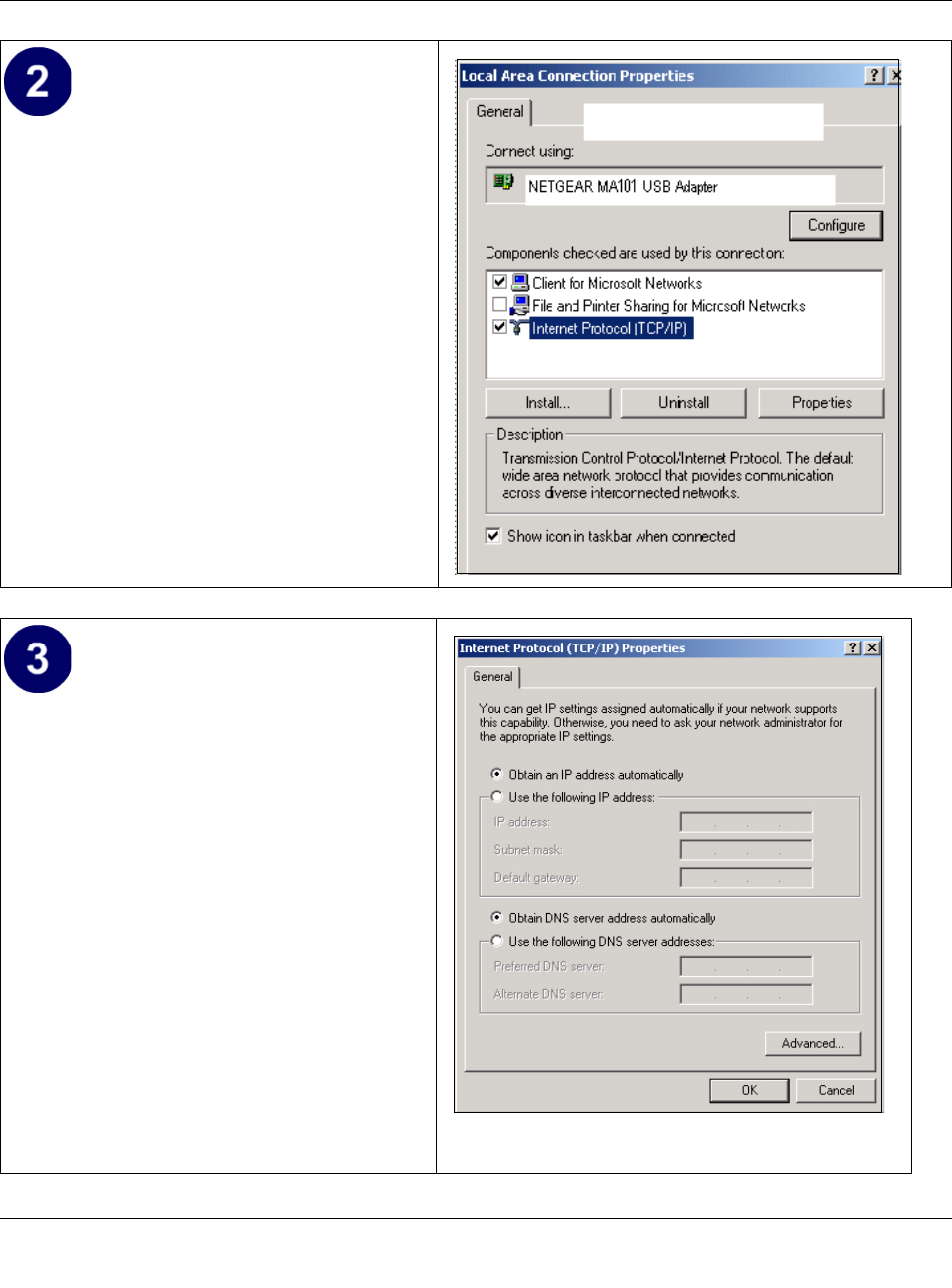
Installation Guide for the NETGEAR 108 Mbps Wireless PCI Adapter WG311T
C-10 Preparing Your PCs for Network Access
The Local Area Connection Properties
dialog box appears. Verify that you have
the correct Ethernet card selected in the
Connect using: box and that the following
two items are displayed and selected in the
box of “Components checked are used by
this connection:”
• Client for Microsoft Networks and
• Internet Protocol (TCP/IP)
Click OK.
With Internet Protocol (TCP/IP) selected,
click on Properties to open the Internet
Protocol (TCP/IP) Properties dialogue
box. Verify that
•Obtain an IP address
automatically is selected.
•Obtain DNS server address
automatically is selected.
Click OK to return to Local Area
Connection Properties. Click OK again to
complete the configuration process.
Restart the PC. Repeat these steps for each
PC with this version of Windows on your
network.

Installation Guide for the NETGEAR 108 Mbps Wireless PCI Adapter WG311T
Preparing Your PCs for Network Access C-11
Verifying TCP/IP Properties for Windows XP or 2000
To check your PC’s TCP/IP configuration:
1. On the Windows taskbar, click the Start button, and then click Run.
The Run window opens.
2. Type cmd and then click OK.
A command window opens
3. Type ipconfig /all
Your IP Configuration information will be listed, and should match the values below if you are
using the default TCP/IP settings that NETGEAR recommends for connecting through a
router or gateway:
• The IP address is between 192.168.0.2 and 192.168.0.254
• The subnet mask is 255.255.255.0
• The default gateway is 192.168.0.1
4. Type exit

Installation Guide for the NETGEAR 108 Mbps Wireless PCI Adapter WG311T
C-12 Preparing Your PCs for Network Access

Glossary 1
Glossary
List of Glossary Terms
Use the list below to find definitions for technical terms used in this manual.
10BASE-T
IEEE 802.3 specification for 10 Mbps Ethernet over twisted pair wiring.
100BASE-Tx
IEEE 802.3 specification for 100 Mbps Ethernet over twisted pair wiring.
802.11b
IEEE specification for wireless networking at 11 Mbps using direct-sequence spread-spectrum (DSSS)
technology and operating in the unlicensed radio spectrum at 2.4GHz.
802.11g
An IEEE specification for wireless networking at 54 Mbps using direct-sequence spread-spectrum (DSSS)
technology and operating in the unlicensed radio spectrum at 2.4GHz. 802.11g is backwards compatible
with 802.11b.
ADSL
Short for asymmetric digital subscriber line, a technology that allows data to be sent over existing copper
telephone lines at data rates of from 1.5 to 9 Mbps when receiving data (known as the downstream rate) and
from 16 to 640 Kbps when sending data (known as the upstream rate).
ADSL requires a special ADSL modem. ADSL is growing in popularity as more areas around the world
gain access.
DHCP
An Ethernet protocol specifying how a centralized DHCP server can assign network configuration
information to multiple DHCP clients. The assigned information includes IP addresses, DNS addresses, and
gateway (router) addresses.
DNS
Short for Domain Name System (or Service), an Internet service that translates domain names into IP
addresses.
Because domain names are alphabetic, they're easier to remember. The Internet however, is really based on
IP addresses. Every time you use a domain name, therefore, a DNS service must translate the name into the
corresponding IP address. For example, the domain name www.example.com might translate to

Installation Guide for the NETGEAR 108 Mbps Wireless PCI Adapter WG311T
2Glossary
198.105.232.4. The DNS system is, in fact, its own network. If one DNS server doesn't know how to
translate a particular domain name, it asks another one, and so on, until the correct IP address is returned.
Domain Name
A descriptive name for an address or group of addresses on the Internet. Domain names are of the form of a
registered entity name plus one of a number of predefined top level suffixes such as .com, .edu, .uk, etc. For
example, in the address mail.NETGEAR.com, mail is a server name and NETGEAR.com is the domain.
DSL
Short for digital subscriber line, but is commonly used in reference to the asymmetric version of this
technology (ADSL) that allows data to be sent over existing copper telephone lines at data rates of from 1.5
to 9 Mbps when receiving data (known as the downstream rate) and from 16 to 640 Kbps when sending data
(known as the upstream rate).
ADSL requires a special ADSL modem. ADSL is growing in popularity as more areas around the world
gain access.
Dynamic Host Configuration Protocol
DHCP. An Ethernet protocol specifying how a centralized DHCP server can assign network configuration
information to multiple DHCP clients. The assigned information includes IP addresses, DNS addresses, and
gateway (router) addresses.
ESSID
The Extended Service Set Identification (ESSID) is a thirty-two character (maximum) alphanumeric key
identifying the wireless local area network.
Gateway
A local device, usually a router, that connects hosts on a local network to other networks.
IETF
Internet Engineering Task Force. Working groups of the IETF propose standard protocols and procedures for
the Internet, which are published as RFCs (Request for Comment) at www.ietf.org.
An open international community of network designers, operators, vendors, and researchers concerned with
the evolution of the Internet architecture and the smooth operation of the Internet.
IP
Internet Protocol is the main internetworking protocol used in the Internet. Used in conjunction with the
Transfer Control Protocol (TCP) to form TCP/IP.
IP Address
A four-byte number uniquely defining each host on the Internet, usually written in dotted-decimal notation
with periods separating the bytes (for example, 134.177.244.57).
Ranges of addresses are assigned by Internic, an organization formed for this purpose.

Installation Guide for the NETGEAR 108 Mbps Wireless PCI Adapter WG311T
Glossary 3
IPX
Short for Internetwork Packet Exchange, a networking protocol used by the Novell NetWare operating
systems.
Like UDP/IP, IPX is a datagram protocol used for connectionless communications. Higher-level protocols,
such as SPX and NCP, are used for additional error recovery services.
ISP
Internet service provider.
Internet Protocol
The main internetworking protocol used in the Internet. Used in conjunction with the Transfer Control
Protocol (TCP) to form TCP/IP.
LAN
A communications network serving users within a limited area, such as one floor of a building.
local area network
LAN. A communications network serving users within a limited area, such as one floor of a building.
A LAN typically connects multiple personal computers and shared network devices such as storage and
printers. Although many technologies exist to implement a LAN, Ethernet is the most common for
connecting personal computers.
MAC address
The Media Access Control address is a unique 48-bit hardware address assigned to every network interface
card. Usually written in the form 01:23:45:67:89:ab.
Mbps
Megabits per second.
NetBIOS
The Network Basic Input Output System is an application programming interface (API) for sharing services
and information on local-area networks (LANs).
Provides for communication between stations of a network where each station is given a name. These names
are alphanumeric names, up to 16 characters in length.
Network Address Translation
NAT. A technique by which several hosts share a single IP address for access to the Internet.
NIC
Network Interface Card. An adapter in a computer which provides connectivity to a network.

Installation Guide for the NETGEAR 108 Mbps Wireless PCI Adapter WG311T
4Glossary
packet
A block of information sent over a network. A packet typically contains a source and destination network
address, some protocol and length information, a block of data, and a checksum.
router
A device that forwards data between networks. An IP router forwards data based on IP source and
destination addresses.
Routing Information Protocol
RIP. A protocol in which routers periodically exchange information with one another so that they can
determine minimum distance paths between sources and destinations.
SSID
A Service Set Identification is a thirty-two character (maximum) alphanumeric key identifying a wireless
local area network. For the wireless devices in a network to communicate with each other, all devices must
be configured with the same SSID.
This is typically the configuration parameter for a wireless PC card. It corresponds to the ESSID in the
wireless Access Point and to the wireless network name. See also Wireless Network Name and ESSID.
Subnet Mask
A mask used to determine what subnet an IP address belongs to. Subnetting enables a network administrator
to further divide an IP address into two or more subnets.
TCP/IP
The main internetworking protocols used in the Internet. The Internet Protocol (IP) used in conjunction with
the Transfer Control Protocol (TCP) form TCP/IP.
WAN
A long distance link used to extend or connect remotely located local area networks. The Internet is a large
WAN.
WEB Proxy Server
A Web proxy server is a specialized HTTP server that allows clients access to the Internet from behind a
firewall.
The proxy server listens for requests from clients within the firewall and forwards these requests to remote
Internet servers outside the firewall. The proxy server reads responses from the external servers and then
sends them to internal client clients.
WEP
Wired Equivalent Privacy is a data encryption protocol for 802.11 wireless networks.
All wireless nodes and access points on the network are configured with a 64-bit or 128-bit Shared Key for
data encryption.

Installation Guide for the NETGEAR 108 Mbps Wireless PCI Adapter WG311T
Glossary 5
wide area network
WAN. A long distance link used to extend or connect remotely located local area networks. The Internet is a
large WAN.
Wi-Fi
A trade name for the 802.11 wireless networking standard, given by the Wireless Ethernet Compatibility
Alliance (WECA, see http://www.wi-fi.net), an industry standards group promoting interoperability among
802.11 devices.
Windows Internet Naming Service
WINS. Windows Internet Naming Service is a server process for resolving Windows-based computer names
to IP addresses.
If a remote network contains a WINS server, your Windows PCs can gather information from that WINS
server about its local hosts. This allows your PCs to browse that remote network using the Windows
Network Neighborhood feature.
WINS
WINS. Windows Internet Naming Service is a server process for resolving Windows-based computer names
to IP addresses.
Wireless Network Name (SSID)
Wireless Network Name (SSID) is the name assigned to a wireless network. This is the same as the SSID or
ESSID configuration parameter.
WPA
Wi-Fi Protected Access (WPA) is data encryption protocol for 802.11 wireless networks. With WPA-PSK
(pre-shared key), all wireless nodes and access points on the network are configured with a Shared Key for
data encryption.

Installation Guide for the NETGEAR 108 Mbps Wireless PCI Adapter WG311T
6Glossary

Index 1
Numerics
802.11b 1
A
Ad-Hoc Mode 2
ad-hoc mode 2
Ad-Hoc Mode Profile 5
B
BSSID 2
C
Configuration Profiles 1
E
ESSID 2
F
features 1
I
Infrastructure Mode 2
infrastructure mode 2
Infrastructure Mode Profile 3
IP networking
for Windows 1,6
N
Networks Page 2
O
Open System authentication 2
P
Passphrase 8,9
Profiles 1
S
Shared Key authentication 2
SSID 3,2
T
TCP/IP properties
verifying for Windows 5
troubleshooting 1
W
WEP 4,2
Wi-Fi 1
Wi-Fi Protected Access (WPA) 11
Windows, configuring for IP routing 1,6
winipcfg utility 5
Wired Equivalent Privacy. See WEP
Wireless Ethernet 1
wireless network name 3
WPA 11
WPA-PSK 8
WPA-PSK Password Phrase 8
Index